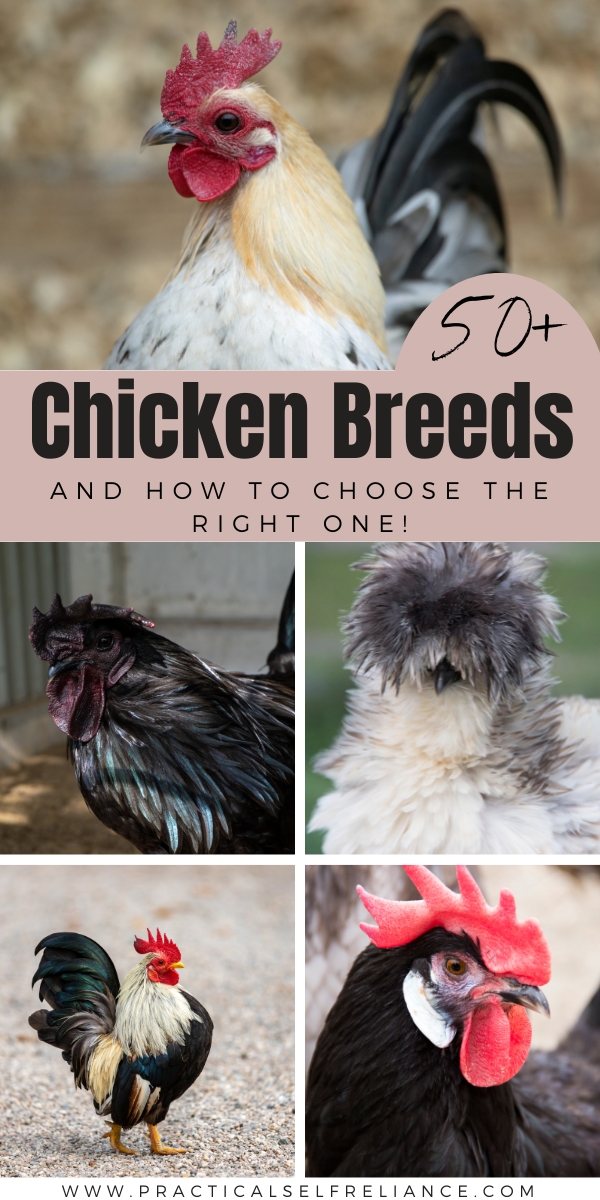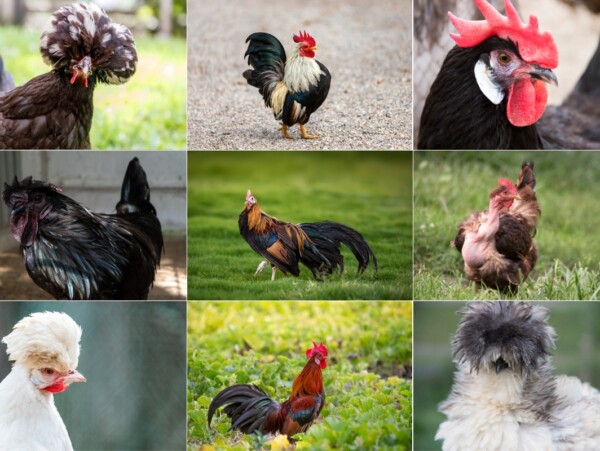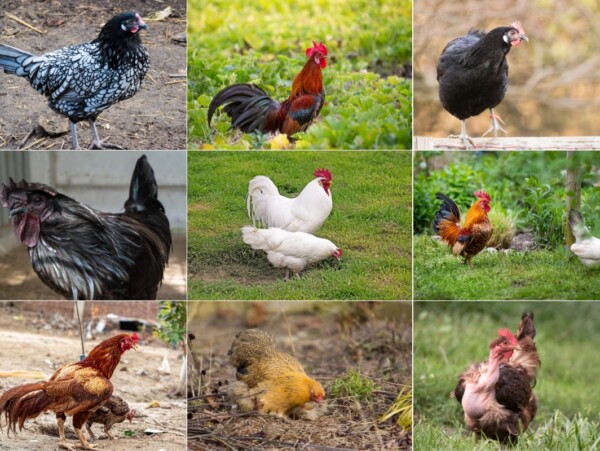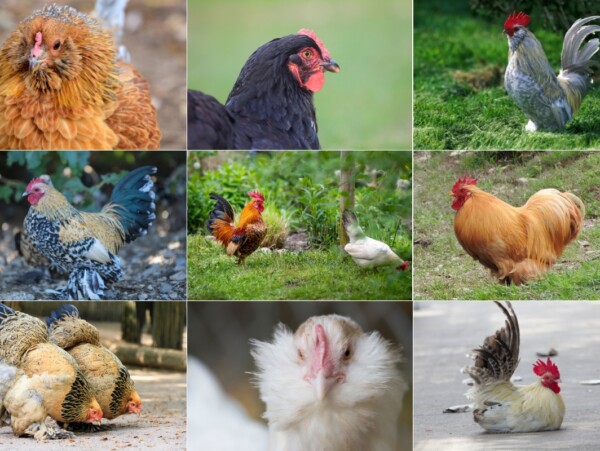Affiliate disclosure: This post may contain affiliate links. Please see our Privacy Policy.
Chicken breeds can be confusing, and finding the best chicken breed for your backyard flock can be hard. Not to worry, I’ve broken them all down for you to help you decide which chicken is best for your space, climate, and goals.
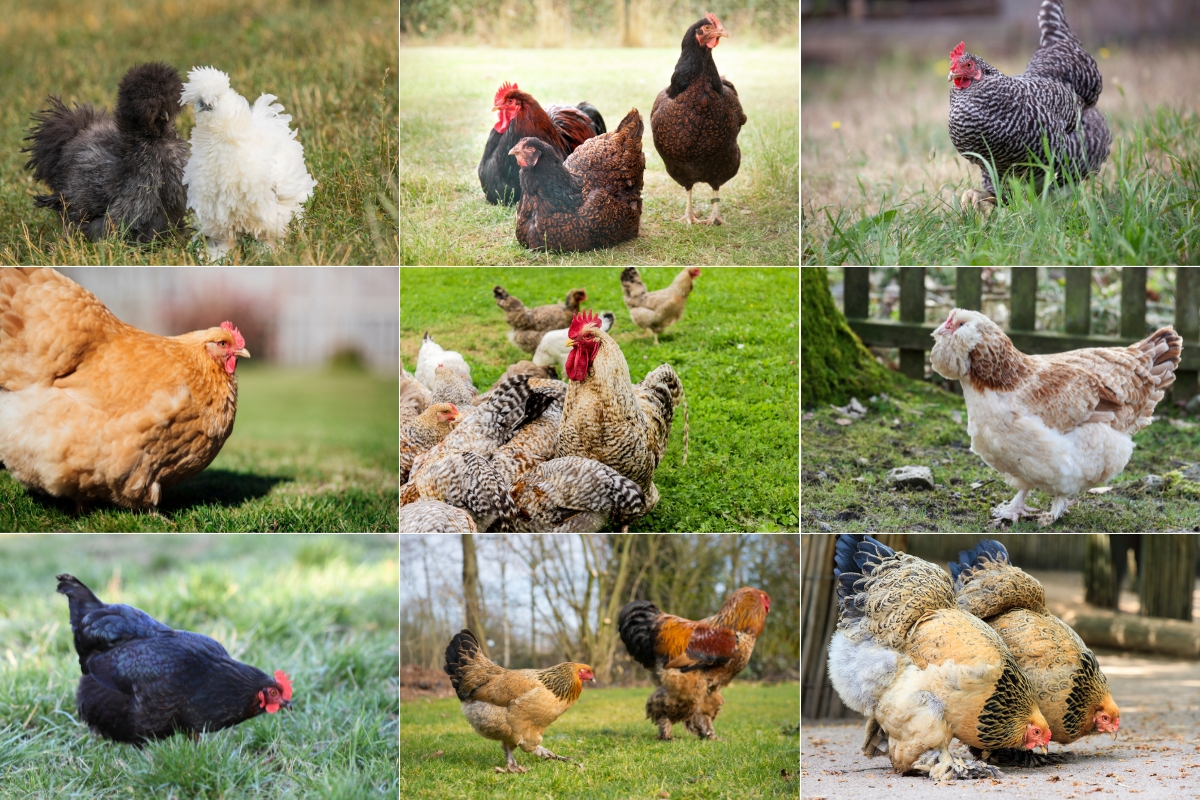
Table of Contents
- Choosing a Chicken Breed
- List of Chicken Breeds
- Chicken Breed Descriptions
- Altsteirer
- Ameraucana
- Ancona
- Andalusian
- Appenzeller Spitzhauben
- Araucana
- Austra White
- Australorp
- Barnevelder
- Basque
- Bielefelder
- Black Sex Link
- Brahma
- Breda
- Buckeye
- Campine
- Catalana
- Chantecler
- Cherry Egger Chicken
- Cochin
- Cream Legbar
- Delaware
- Dominique
- Dorking
- Easter Egger
- Faverolles
- Hamburg
- Icelandic
- Iowa Blue
- Isbar
- Java
- Jersey Giant
- Langshan
- Leghorns (White and Brown)
- Marans
- Minorca
- Niederrheiner
- New Hampshire
- Norwegian Jaerhon
- Olive Egger
- Orpington (Buff, Lavender, etc)
- Penedesenca
- Plymouth Rock (White Rock and Barred Rock)
- Red Sex Link (Cinnamon Queen, Golden Comet)
- Rhode Island Red
- Russian Orloff
- Sussex
- Swedish Black Hen
- Swedish Flower Hen
- Turken (Naked Neck)
- Vorwerk
- Welsummer
- Whiting True Blue
- Wyandotte
- Chicken Keeping Guides
Many years ago, when we first started keeping backyard chickens, we simply picked up day-old chickens from our local feed store. They had just 3 to 4 breeds, your standard selection of Rhode Island Red, Barred Rock, Buff Orpington for eggs, and Cornish Cross as a meat chicken.
Back then, I had no idea that those chicken breeds were only the beginning.
There are at least a hundred relatively common chicken breeds, and even more obscure ones kept by specialty breeders.
With the rise in backyard chicken keeping, hatcheries are reviving many of the unique heritage breeds that once dominated the chicken world, and we’re seeing all manner of egg colors, personalities, feather types, and sizes.
There truly is a perfect chicken breed for everyone…the hard part is figuring out the best chicken breed for your unique needs.

Choosing a Chicken Breed
There are a lot of considerations when choosing a chicken breed, and it goes way beyond selecting an “egg-laying” or “meat breed.”
It’s important to consider temperament, feather type, heat/cold hardiness, body size, egg-laying ability, and much more when choosing the best chicken breed for your family.
If you’re simply looking for quick guides, I’d suggest reading these “best of” lists, which cover most of the common considerations:
- Best Egg Laying Chickens Breeds for Beginners
- Chickens that Lay Colorful Eggs
- Cold Hardy Chicken Breeds
- Heat Tolerant Chicken Breeds
- Chickens with Feathered Feet
- Fluffy Chicken Breeds
- Ornamental Chicken Breeds (for Beauty and Show)
- Best Broody Chicken Breeds for a Self-Maintaining Flock
- Chickens That Lay the Most Eggs
- Best Dual Purpose Chicken Bree
And coming soon:
- Best Meat Chickens
- Best Chickens for Kids
- Bantam Chicken Breeds for Small Spaces
- Best Chickens for a Small Flock
- Best Chickens for the Suburbs (Quiet, docile, and good in a small coop)
If you really want to know how to choose a chicken breed in detail, I’ll take you through all the considerations and all the common (and not-so-common) chicken breeds.
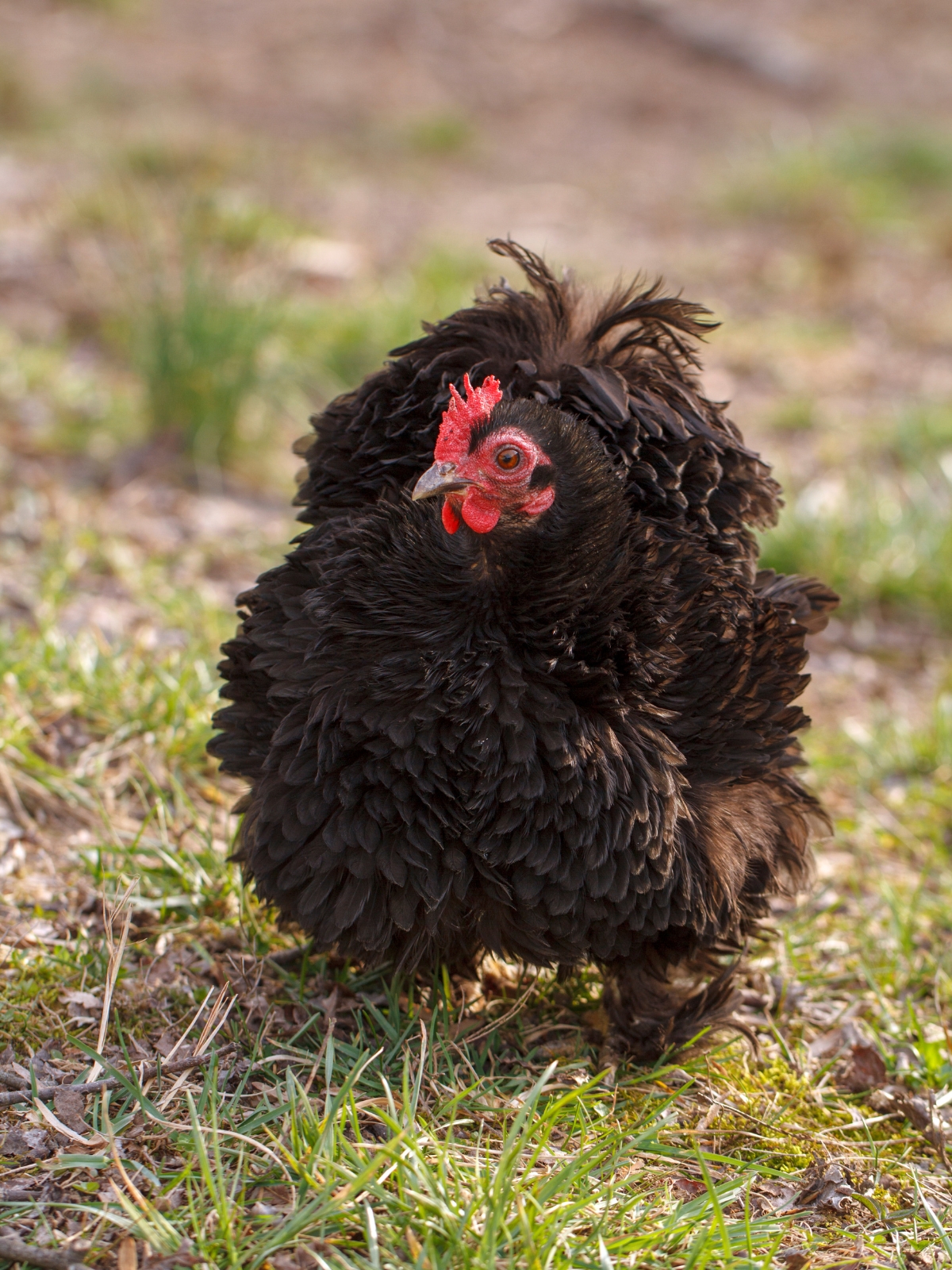
Breed Type
As a homesteader, I’m biased toward “dual purpose” chicken breeds that can be kept for both eggs and meat. We try to raise a self sustaining flock that reproduces on their own, and we harvest the surplus males for the table while keeping the hens for egg laying.
Not everyone wants both eggs and meat, and ornamental chicken keepers only want pets, so it’s all up to your goals in the end.
- Egg Laying – Mostly small-bodied chickens that lay over 200 eggs a year, with some of the best-laying breeds producing 340+ eggs a year. These have a good feed-to-egg conversion ratio because they’re not bulky breeds. Some are larger-bodied, but those are generally considered “dual purpose” breeds, since they’re also
- Meat Breeds—Generally large-bodied and fast-growing, meat breeds put on a lot of bulk quickly, so they reach a good broiler size while their meat is still tender. Most don’t lay many eggs, and some are “hybrid” first-generation chickens, like the well-known Cornish Cross Breed.
- Dual Purpose—With large bodies and good egg-laying capabilities, dual-purpose chickens are perfect if you want both eggs and meat. They eat more than simple egg-laying chickens but grow bigger. They also take a bit longer to mature than straight-meat chickens, but they lay more eggs than single-purpose meat chickens, so it balances out.
- Ornamental – Many of the more exotic chicken breeds are considered purely ornamental, for exhibitions and specialty chicken shows. Most don’t lay many eggs, and they’re too small to be worth the meat. Mostly they are just kept for show, and they have some pretty outlandish characteristics. Some even have tails that are several yards long!
I’m going to cover egg-laying, dual-purpose, and meat breeds in detail. Ornamental, show, and novelty chicken breeds are kept by some people as pets, but they’re not all that common (or readily available).
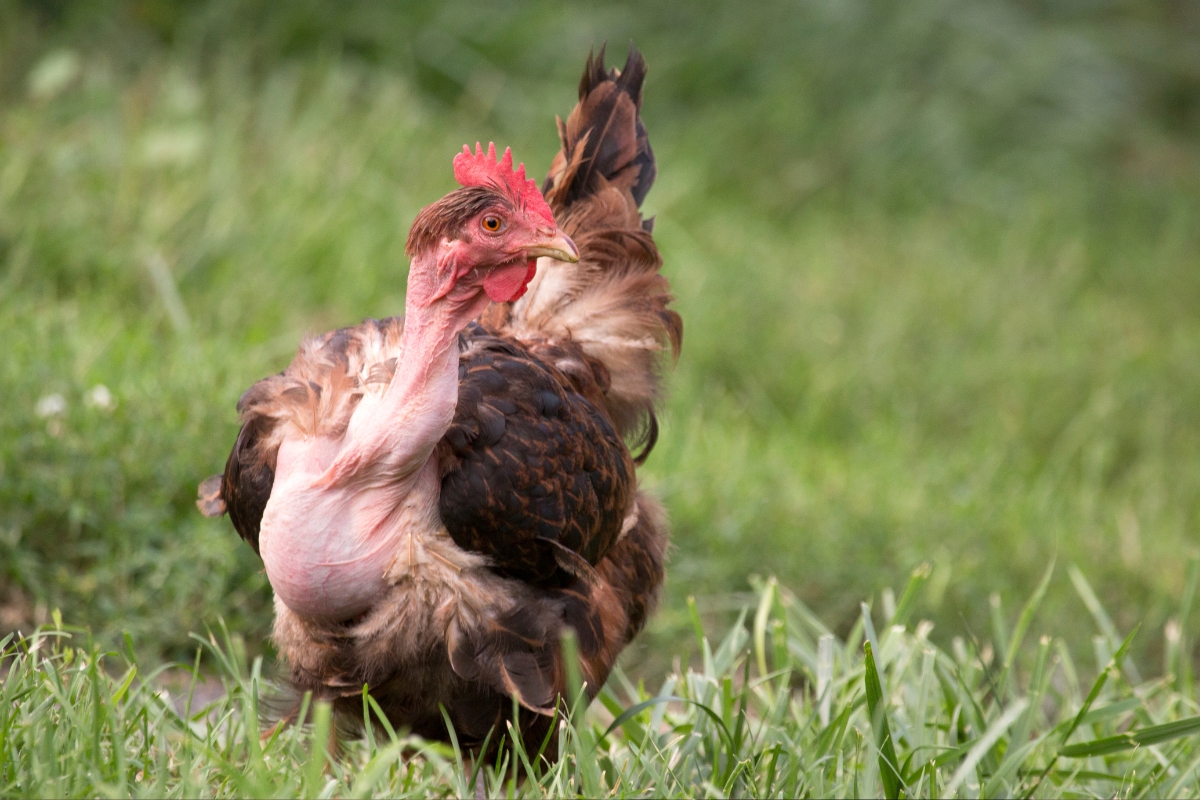
Body Size
Size matters when it comes to chickens, and smaller birds take up less space in the coop and eat a lot less, too. Small birds generally lay smaller eggs, and are often easier for predators to pick off.
Larger birds tend to be dual purpose, often lay bigger eggs, and are better able to deter predators, but they take longer to mature and eat considerably more.
- Bantam– With small bodies and big personalities, bantam breeds are generally about half the size of full-sized breeds. Some are exceptionally small, and Serama chickens weigh only about a pound when fully grown, but most are under 2 lbs. Bantams lay small eggs that are about half the size of a normal egg.
- Full Size– Full-sized chickens range from 5 lbs to about 9 pounds. Anything too much smaller, and they’re a bantam, and over 9 pounds is a “jumbo” breed. The vast majority of chicken breeds fall into this range. Commercial meat birds are also in this category, as most people want chickens that finish in this size range.
- Jumbo Breeds—Often raised as dual-purpose birds, these are mostly heirloom breeds developed to provide plenty of meat and eggs. They usually take quite a while to grow to full size, sometimes eight months or more. These breeds eat more and take up more space in the coop, but they also yield a lot of meat at harvest time and a good supply of eggs. Many of these breeds lay extra-large and jumbo eggs, too.
I’ll cover full-size and jumbo breeds in this article and save bantam breeds for a separate discussion. Many of the “full-sized” breeds actually have a bantam version that has the same characteristics but was just bred smaller.
Other bantam breeds are their own specific breed, and they don’t have a full-sized counterpart.
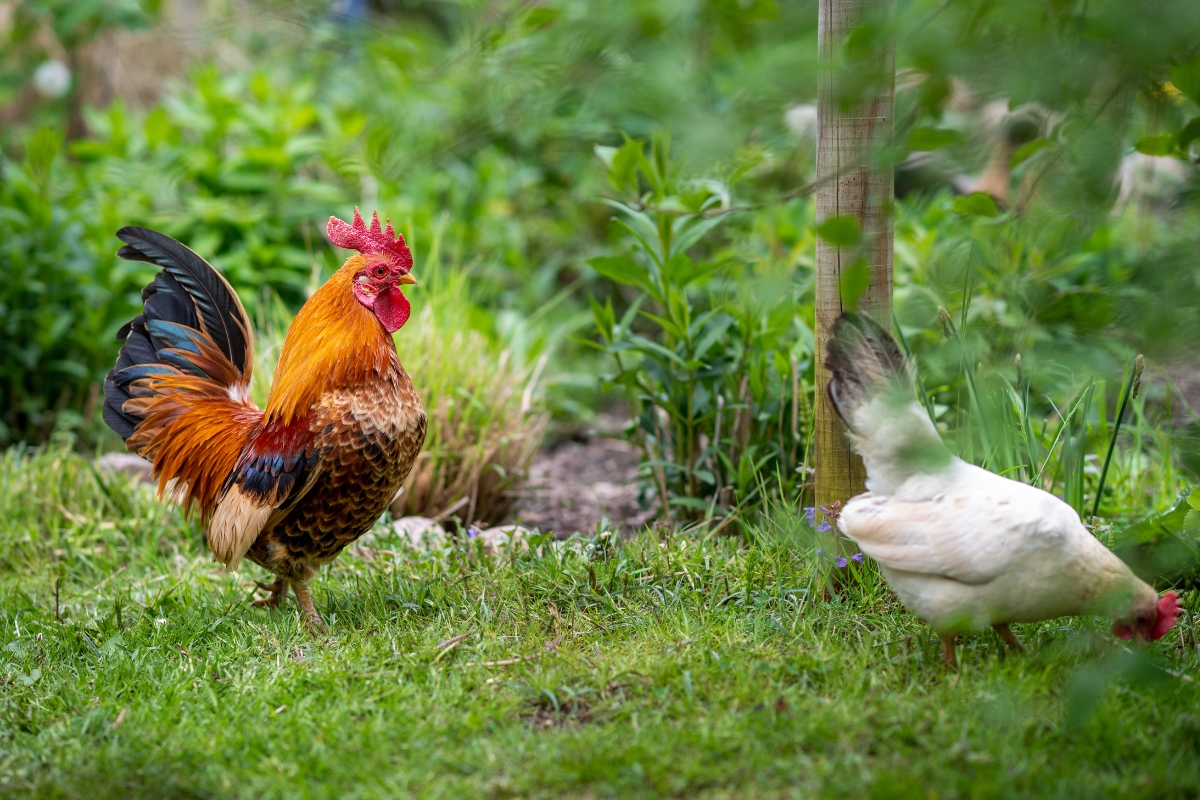
Temperament
Do you want a friendly lap chicken, or would you rather the chickens mostly stay away from you and keep to themselves?
Friendly breeds can be a real pleasure, but having a snuggly chicken always underfoot can also be annoying. The more aggressive breeds might not be the best for families with children, but they tend to be more independent and better at fighting off predators.
Besides friendly or aggressive dispositions, there are also calm versus active, as some breeds are much quieter, more chill, and more sedate than others. Some breeds are considered nervous and flighty, even if otherwise friendly.
Predator-aware breeds are good at keeping watch for hawks and sounding the alarm, while other breeds are oblivious to the danger.
And lastly, you’ll need to know if they’re good foragers (which cuts down on feed costs if you free range) or if they tolerate confinement (if you don’t free range).

Egg Laying Ability
All chickens lay eggs, even the “ornamental” types. Some of the best egg-laying breeds can lay around 350 eggs per year, while the least productive show chickens might only lay a few dozen. Beyond quantity, there’s also size and color.
Many production chickens are bred to lay large and jumbo-sized eggs, while most of the heritage breeds lay medium to large eggs. Bantam breeds lay miniature eggs, sometimes only around 1/4 the side of a typical egg.
Egg color is another fun consideration if you want a rainbow of eggs in your basket. The color of an eggshell doesn’t impact its flavor or quality, but it’s especially fun to collect and display a variety of shell colors from your own backyard coop.
If you’re looking for a specific egg color, you can read through my breed guides for each egg color:
- White Eggs
- Brown Eggs
- Dark Brown Eggs (Chocolate Eggs)
- Blue Eggs (Easter Eggers)
- Green Eggs (Olive Eggers)
- Pink Eggs
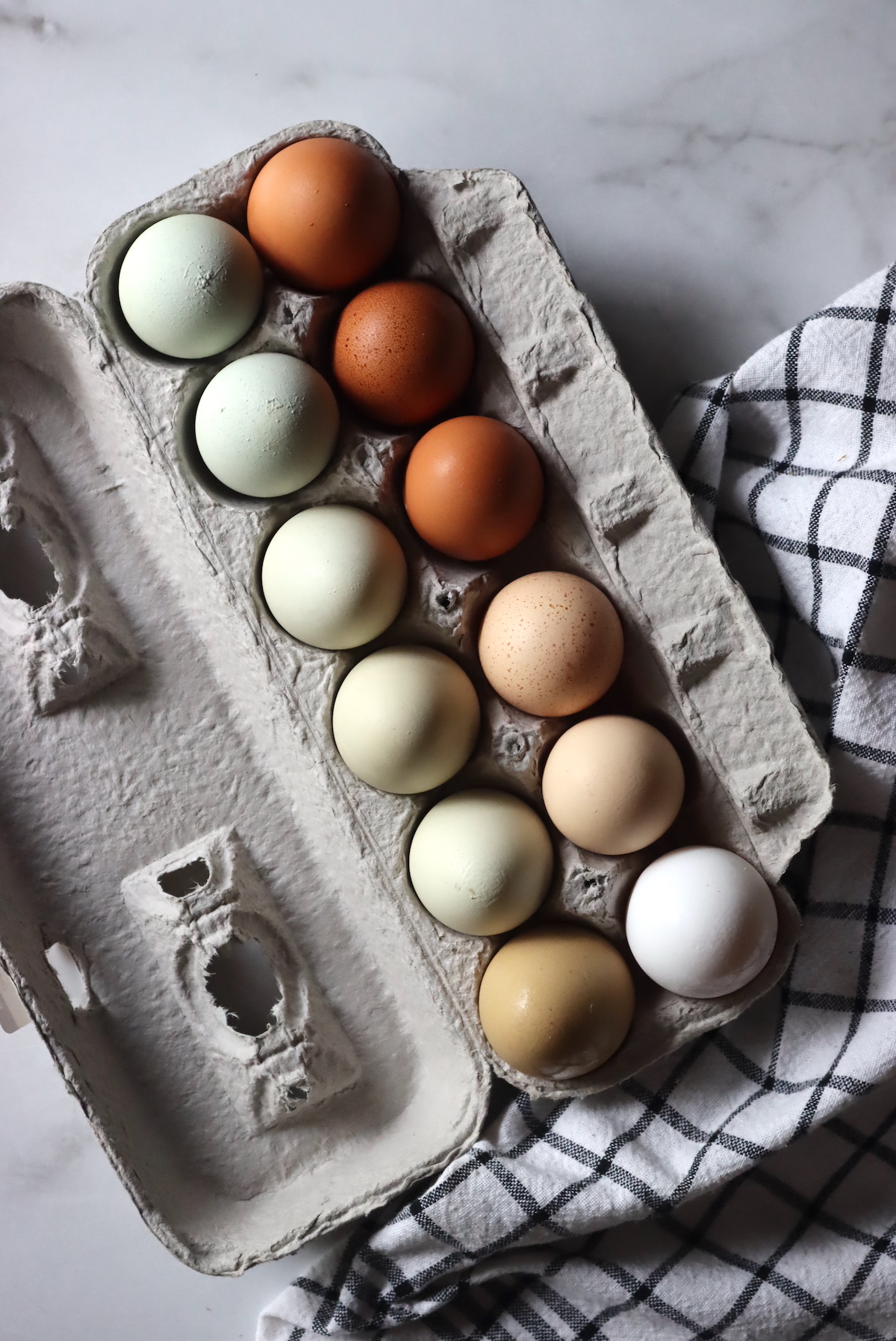
Lifespan and Time to Maturity
Most chickens live around 6 to 10 years, regardless of breed. However, a chicken’s productive lifespan can vary dramatically by breed.
Many heritage breeds tend to lay fewer eggs, but for a longer period of time. It’s not uncommon to have a heritage hen laying well into her 4th or 5th year. Modern production breeds tend to lay lots of eggs quickly, and they’ll usually only lay for their first 2 years of life (but still live as long as any other breed).
Some of the best-production egg layers will begin laying as young as 18 weeks, while other slower-maturing heritage breeds (and jumbo breeds) might not begin laying until around 26 weeks.
If you want high egg production and plan to turn over your flock every two years, then production breeds are your best bet. If you want to develop a longer-term relationship with your chickens, and plan on supporting them in their old age (rather than retiring them to the freezer), then opt for heritage breeds that maintain productivity longer.
Feathering
More than just for show, a chicken’s feathers help determine its cold hardiness or heat tolerance and how it stands up to climates with heavy rain. Certain feather types require more maintenance from the chicken keeper, while others are worry-free and self-maintaining.
Silkies, for example, have fluffy feathers that don’t do well in wet climates and require maintenance if they get wet or muddy.
Other feather patterns that may impact a breeds suitability include muffs, beards, ear tuffts, crests and feathered feet. All of these imply extra feathers on one part of the body or another.
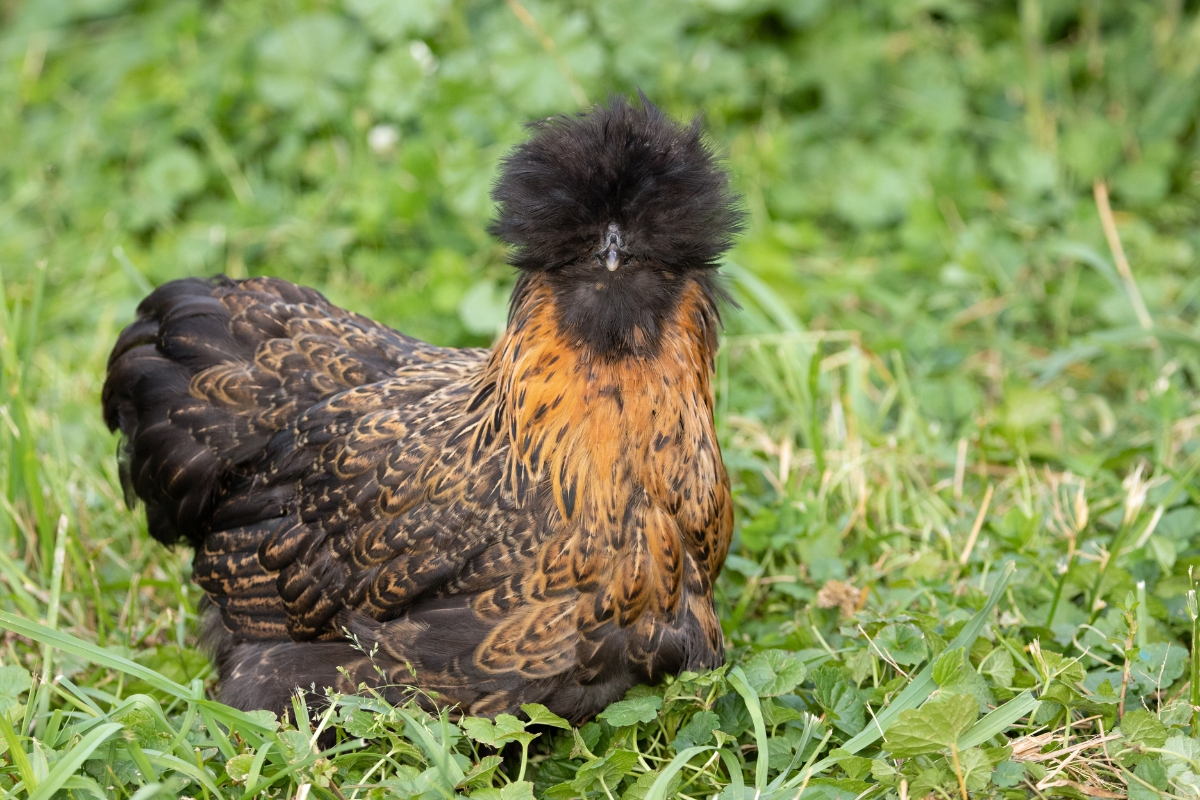
Comb Type
A chicken’s comb type is partially just for show, but it actually helps determine their cold hardiness and heat tolerance. Large combs work well in hot environments, as they can help a chicken dissipate heat.
Conversely, smaller combs are better for very cold climates, as big combs tend to get frostbite.
Large comb types include single combs (most common), rose, buttercup and carnation.
Small comb types include pea combs (most common), strawberry combs, walnut combs, cushion combs, and V combs.
This article has excellent pictures of each comb type.
List of Chicken Breeds
This list of chicken breeds covers all of the common (and not-so-common) chicken breeds available today, from bantams to full-size, egg layers to meat chickens and ornamental birds.
I’ll cover each of these breeds in detail, including egg-laying, meat chickens, dual-purpose chickens, pet chicken breeds, and bantam chicken breeds.
I’ve done my best to group them into true breeds, but when you add crossbreeds, things get tricky quickly. Most chicken breeds have a bantam counterpart that has been bred to be small, and others have been extensively crossbred for certain characteristics.
For example, Frizzle Cochin Bantams are a cross between frizzle chickens (with fluffy feathers) and feather-legged cochins, then bred down to be micro-sized. They’re like a little feathered poodle the size of a pigeon. They’re not a true breed on their own, but some of the major hatcheries still sell them.
Egg Laying & Dual Purpose Chicken Breeds
This list of chicken breeds covers the vast majority of the breeds you’ll find on just about any homestead or backyard coop. Specific meat breeds (generally not kept for more than 8 to 16 weeks) are listed separately.
- Altsteirer
- Ameraucana
- Ancona
- Andalusian
- Appenzeller Spitzhauben
- Araucana
- Austra White
- Australorp
- Barnevelder
- Basque
- Bielefelder
- Black Sex Link
- Brahma
- Breda
- Buckeye
- Campine
- Catalana
- Chantecler
- Cherry Egger Chicken
- Cochin
- Cream Legbar
- Delaware
- Dominique
- Dorking
- Easter Egger
- Faverolles
- Frizzle
- Hamburg
- Icelandic
- Iowa Blue
- Isbar
- Jaerhon
- Java
- Jersey Giant
- Langshan
- Leghorns (White and Brown)
- Marans (Black Copper, and others)
- Minorca
- Niederrheiner
- New Hampshire
- Norwegian Jaerhon
- Olive Egger
- Orpington (Buff, Lavender, etc)
- Penedesenca
- Plymouth Rock (Barred Rock, White Rock, etc)
- Polish
- Red Sex Link (Cinnamon Queen)
- Rhode Island Red
- Russian Orloff
- Silkie
- Sussex
- Swedish Black Hen
- Swedish Flower Hen
- Turken (Naked Neck)
- Vorwerk
- Welsummer
- Whiting True Blue
- Wyandotte
Meat Chicken Breeds
These breeds are generally purchased from hatcheries and raised for 8 to 16 weeks as broilers. They’re almost all hybrids, and cannot survive past maturity at just a few weeks old.
These are hybrids, specifically bred for incredibly fast growth and excellent feed conversion. If you want to keep a self-sustaining meat flock, choose a dual-purpose breed instead.
- Breese
- Big Red Broiler
- Cornish Cross
- Dark Cornish
- Ginger Broiler
- Kosher King
- Orloff
- Red Ranger
Since these are generally not kept for longer than it takes to raise them to table size, I’ve saved them for a separate article on meat chicken breeds (coming soon).
(Most of these breeds actually have what’s known as “low survivability,” meaning they actually just die before they reach laying age, so you have to process them early or they’ll just die on their own. They’re propagated as hybrids, and the parent breeds can lay eggs..that’s how they’re still available, but only from hatcheries. If you’re looking for a more natural choice for meat, opt for a dual-purpose breed instead.)
Chicken Breed Descriptions
Here’s where you’ll find a description of more than 70 common chicken breeds, from A to Z. All of these breeds are either egg-laying breeds or dual-purpose (meat and egg) breeds, with normal or jumbo body sizes.
If you’re looking for bantams, check out my bantam chicken breed guide (coming soon). I also have a separate guide to specific meat breeds (coming soon) that aren’t kept for eggs, and generally don’t live past 8 to 16 weeks old.
Altsteirer
The Altsteirer is a great example of a landrace breed or one that has naturally adapted to its local environment and has been domesticated. The Altsteirer likely originated in the Styrian regions of Austria and Slovenia. It was domesticated throughout much of the Alps. In the 1800s, there was a push for the breed to become standardized, led by Armin Arbeiter and Emanuel Martiny. The breed standard in Europe was written in 1902. The Altsteirer remained one of the most culturally important and popular breeds in the area until World War II, when these birds were replaced by chickens that were bred solely for production. Fascinatingly enough, despite being accustomed to the cold of the mountains, Altsteirer chickens may be closely related to Mediterranean chickens, like the Leghorn!
Altsteirers are attractive birds–they are compact, medium-sized, athletic chickens. They have a single comb and a crest of feathers atop their heads, resembling a crown. Their plumage comes in various colors, with the main types being red-brown, white, and barred. The feather patterns can differ based on the color variety.
The Altsteirer is a great dual-purpose breed. It can lay up to 200 eggs per year and yield a decently large carcass when butchered. As a landrace breed, Altsteirers are experts at free-ranging. They’re very robust, active, and alert. Altsteirers are highly independent, so you don’t have to worry about giving them enough attention.
- Breed Name: Altsteirer, Styrian chicken, Styrian hen
- Breed Type: Dual-purpose
- Temperament: Confident, bold, active
- Size: Hens 4.4 lbs, roosters 6.6 lbs
- Eggs Per Year: 150-200
- Egg Size: Medium
- Egg Color: White or tinted
- Feather Type: Hard, clean legs
- Comb Type: Single
- Hardiness: Very cold hardy
- Lifespan: 8+ years
- Time To Maturity: 20 weeks

Ameraucana
The classic choice if you want blue eggs in your basket, Ameraucanas are blue egg-laying chickens that have friendly, curious personalities and exceptional foraging abilities.
It was bred from Araucanas, a breed from Chile that occasionally laid blue eggs but had genetic issues that made it less than ideal. Ameraucanas (similar name, but a new, improved breed) resolve all these issues and are a fun, dependable addition to your backyard flock.
You can read more about this breed in my Ameraucana Chicken Breed Guide.
- Breed Name: Ameraucana (Pronounced: UH-MEH-RAU-KAA-NUH)
- Breed Type: Egg-Laying Breed
- Temperament: Curious, docile, good foragers
- Size: Hens 5 1/2 lbs. and Roosters 6 1/2 lbs.
- Eggs Per Year: 150-200
- Egg Size: Medium
- Egg Color: Blue, with occasional green tints
- Feather Type: Standard, with trim muffs and clean legs
- Comb Type: Pea Comb
- Hardiness: Cold Hardy, and Heat Tolerant
- Lifespan: 7-8 years
- Time To Maturity: 20 to 24 Weeks
The benefits of Ameraucanas include:
- Excellent foragers
- Light blue eggs
- Cold and heat hardy
- Good layers
- Tender meat
- Docile and curious
The downsides of Ameraucanas include:
- Do not enjoy being handled
- Less meat than the average
- Hatched chicks prone to cross-beak
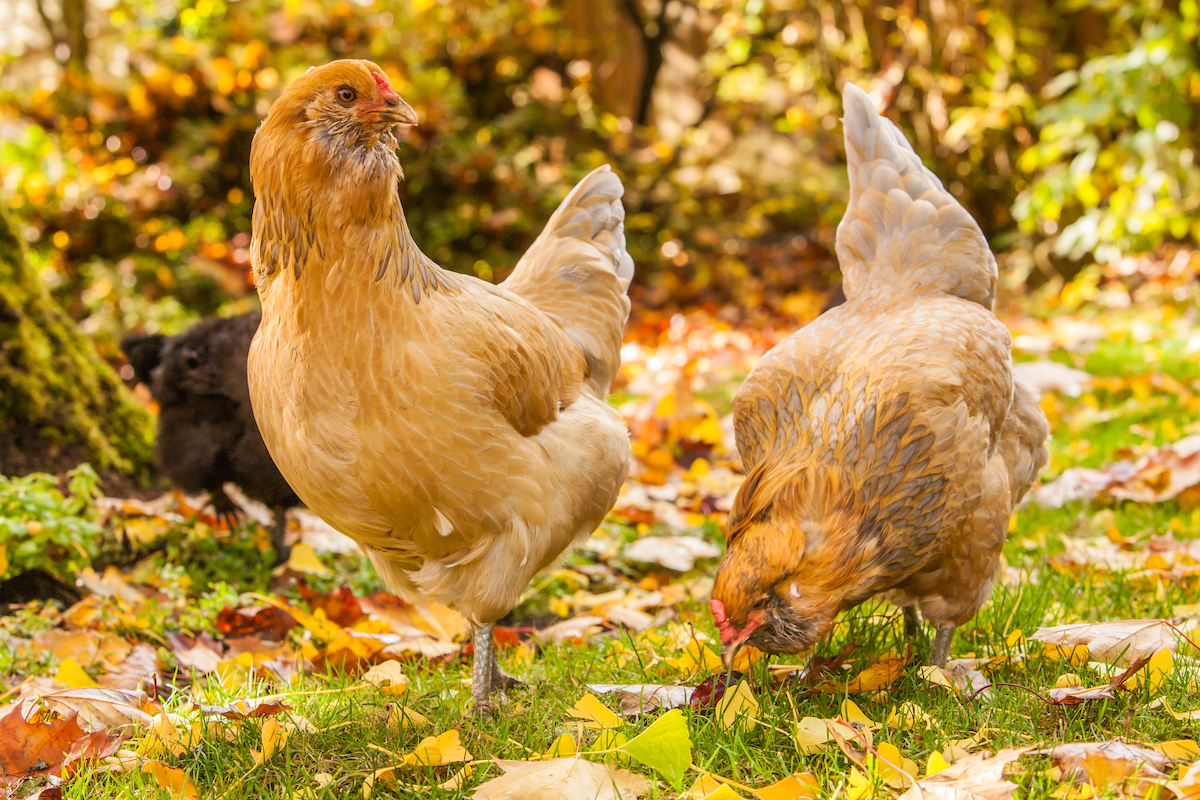
Ancona
An Italian heritage breed, the Ancona chicken is an adaptable breed that tolerates heat exceptionally well, but can also deal with cold weather to some degree. They have a large comb, which is ideal for hot climates.
A reliable layer, they’ll produce 180 to 220 eggs a year, which puts them about in the middle of the road production-wise. It’s not an intense layer, but still enough to be worthwhile.
They’re great foragers, but also flighty and active, so be sure you have plenty of space for them to roam. They’re intelligent and predator-aware, which is a great combination for a free-range bird.
- Breed Name: Ancona
- Breed Type: Mediterranean, layer
- Size: Hens 4.5 lbs, roosters 6 lbs
- Personality: Flighty, active
- Eggs per year: 180-220
- Egg size: Large
- Egg color: White
- Hardiness: Heat-tolerant
- Comb type: Single
- Feather type: Standard, clean legs
- Lifespan: 8+ years
- Time to Maturity: 20-24 weeks
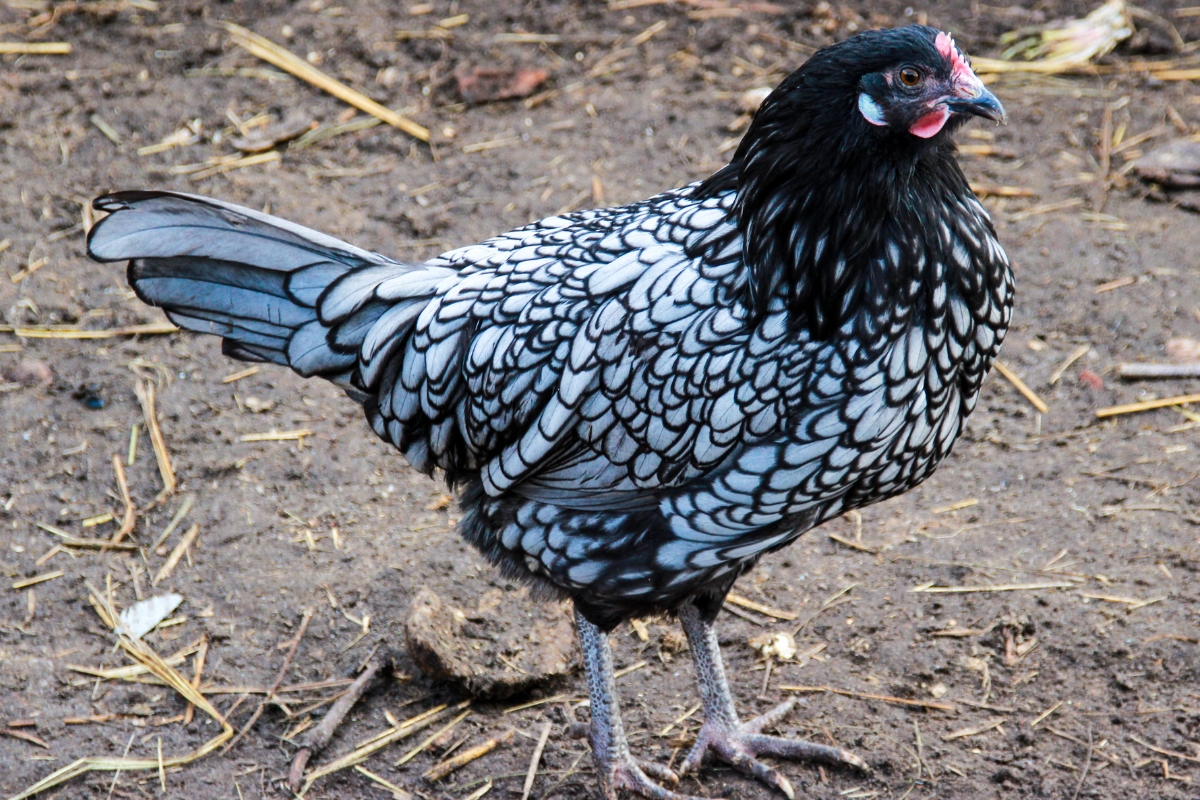
Andalusian
This Mediterranean breed boasts stunning plumage and a gentle, curious personality. Compared to other Mediterranean breeds, Andalusian chickens are much friendlier and more sociable with people.
They’re well-adapted to hot climates, and raised for meat and eggs.
- Breed Name: Andalusian
- Breed Type: Mediterranean
- Size: Hens 5.5 lbs, roosters 6 lbs
- Temperament: Friendly, active, curious
- Eggs per year: 150
- Egg color: White
- Hardiness: Heat tolerant, tolerates some cold
- Comb type: Single
- Feather type: Standard, clean legs
- Lifespan: 8+ years
- Time to Maturity: 20 weeks
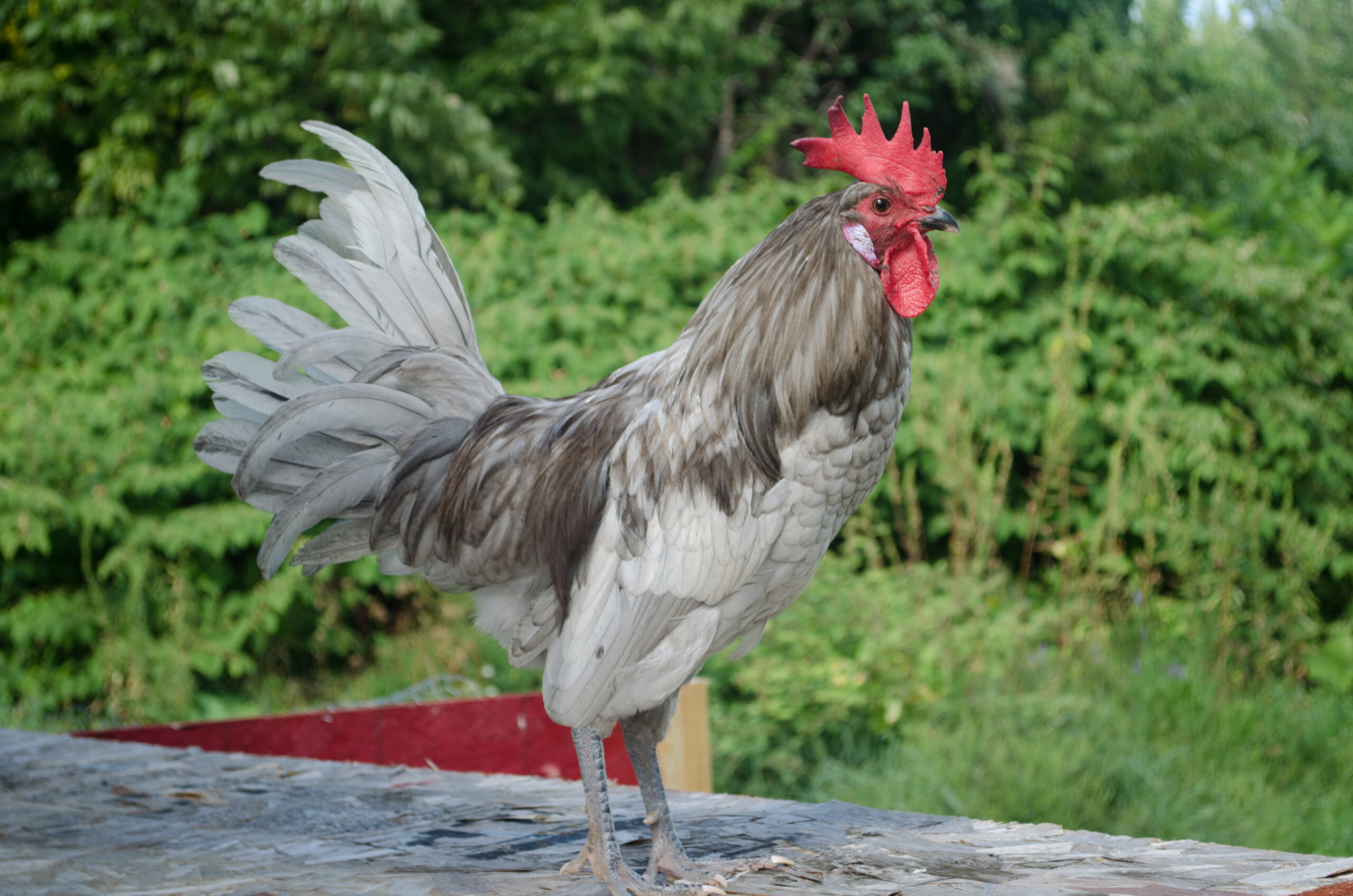
Appenzeller Spitzhauben
Originating in Medieval Swiss Monestaries, the Appenzeller Spithauben is a cold-hardy breed usually raised for eggs. The breed is not currently recognized by the APA due to a lack of standardization within it, but passionate breeders are working to correct that.
They’re excellent foragers and high-energy, independent birds. They tend to stay on alert for predators, helping to keep all their flockmates safe from predators.
As an active breed, they don’t take well to confinement and need plenty of space to roam and forage.
- Breed Name: Appenzeller Spitzhauben (app-uhn-zell-urr spits-haw-ben)
- Breed Type: Layer
- Temperament: Flighty, excited, active
- Size: Hens 3.5 lbs, roosters 4.5 lbs
- Eggs Per Year: 150-180
- Egg Size: Medium to large
- Egg Color: White or tinted
- Feather Type: Standard, clean legs
- Comb Type: V-comb
- Hardiness: Cold hardy
- Lifespan: 5+ years
- Time To Maturity: 20-22 weeks
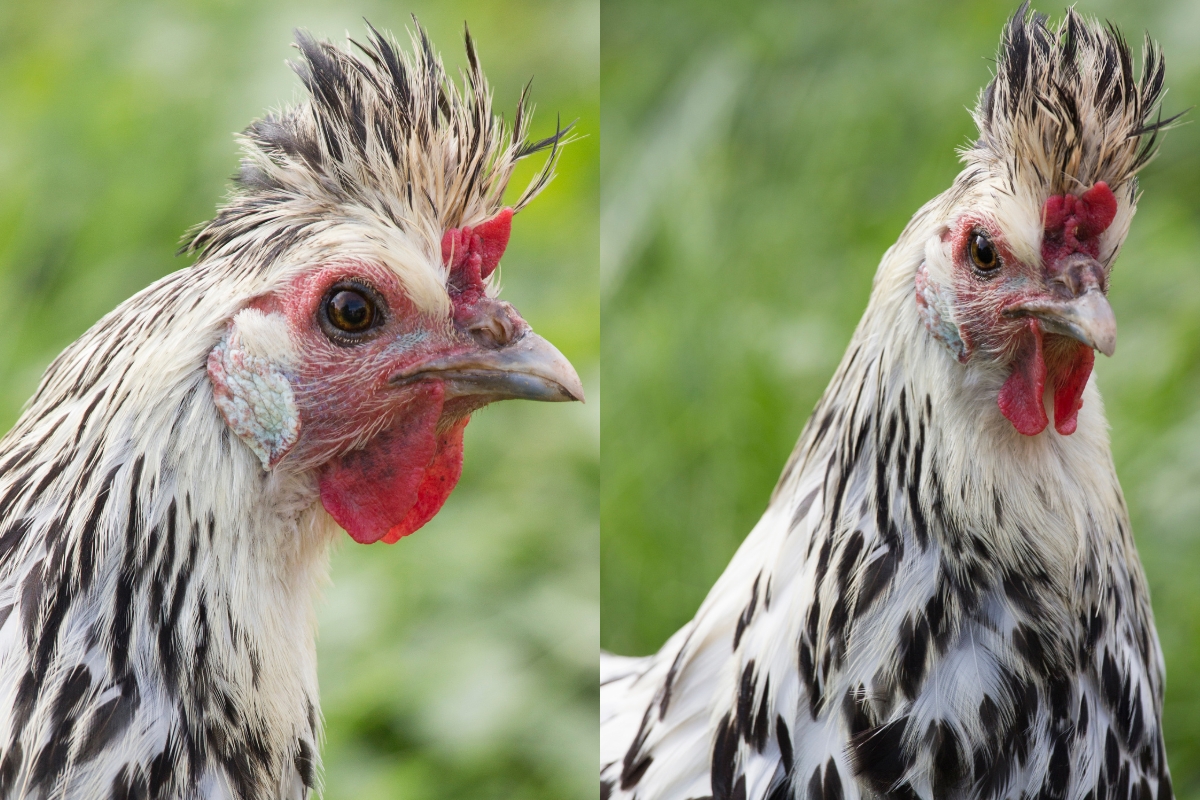
Araucana
A stunningly beautiful chicken, Araucanas are also excellent layers of lovely blue eggs. They were brought to the US from Chile, and are the parent breed to Ameraucanas and Easter Eggers.
They lack a tail, which makes them unique in the chicken world. Their elaborate ear tufts are also pretty striking.
Sometimes independent, but sometimes affectionate, you never quite know what you’re going to get with an Araucana. Either way, they’re lovely to look at, and their eggs will brighten up your egg basket, too!
- Breed Name: Araucana (ah-ruhh-caw-nuhh)
- Breed Type: Layer, ornamental
- Temperament: Active, docile, curious
- Size: Hens 5 lbs, roosters 6 lbs
- Eggs Per Year: 250
- Egg Size: Medium to large
- Egg Color: Blue
- Feather Type: Hard, clean legs with muffs and ear tufts. No tail.
- Comb Type: Pea
- Hardiness: Cold hardy and heat tolerant
- Lifespan: 8+ years
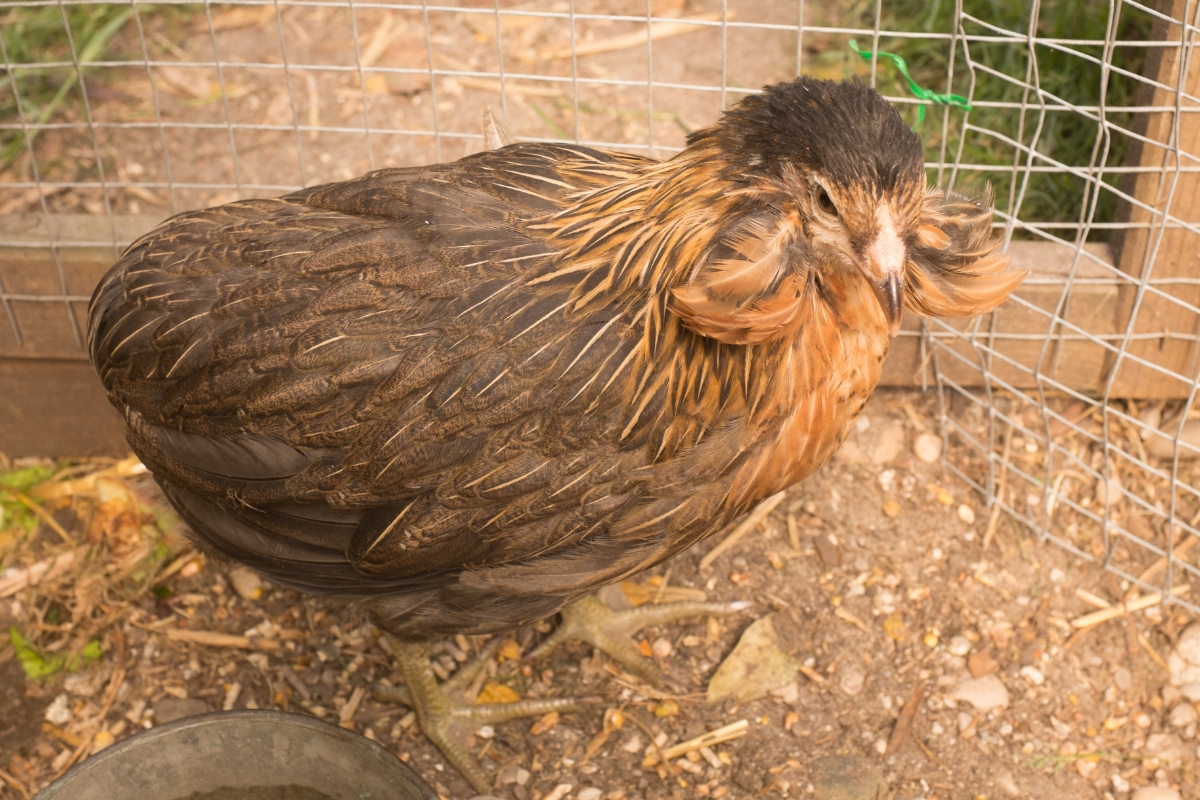
Austra White
The Austra White chicken is a hybrid developed by crossing an Australorp and a White Leghorn. Dunlap Hatchery developed the Austra White in the United States. Australorps and White Leghorns are superstar layers, so the crossing of these two resulted in a hybrid known for its outstanding egg-laying capacity.
The Austra White is a perfect example of an efficient and prolific egg layer, laying upwards of 300 eggs per year! They don’t need as much feed as some other layer breeds, either, and are good at foraging. Beyond eggs, Austra Whites are great pets. They’re generally docile and hardy, making them perfect for both rural and suburban settings. Austra Whites are also large enough to be table birds. The Austra White chicken is sleek and attractive. They have pretty white plumage with occasional black flecks, and their bright red single combs add a pop of color. Austra Whites are medium-sized, with hens being around 5 lbs and roosters 6.5 lbs.
- Breed Name: Austra White
- Breed Type: Dual-purpose
- Temperament: Calm, friendly, easygoing
- Size: Hens 5 lbs, roosters 6.5 lbs
- Eggs Per Year: 200-250
- Egg Size: Large
- Egg Color: White
- Feather Type: Hard, clean legs
- Comb Type: Single
- Hardiness: Heat tolerant and cold hardy
- Lifespan: 6-10 years
- Time To Maturity: 20-24 weeks
Australorp
Similar to Orpington chickens, Australorp chickens are said to be the Australian version of the breed (though other sources say the name is just by chance, and they’re a British development).
The record for most eggs laid in a year by a single hen is held by an Australorp. That particular record-setting hen laid 371 eggs in a year, which is more than one every single day. In general, they are productive, but more commonly lay 250 to 300 eggs per year.
- Breed Name: Australorp
- Breed Type: English, dual-purpose (meat and eggs)
- Temperament: Calm, easygoing, gentle
- Size: Hens 6 lbs, roosters 10 lbs
- Eggs Per Year: 250-300
- Egg Size: Large
- Egg Color: Light brown
- Feather Type: Standard, clean legs
- Comb Type: Single
- Hardiness: Cold hardy and heat tolerant
- Lifespan: 8+ years
- Time To Maturity: 20-22 weeks
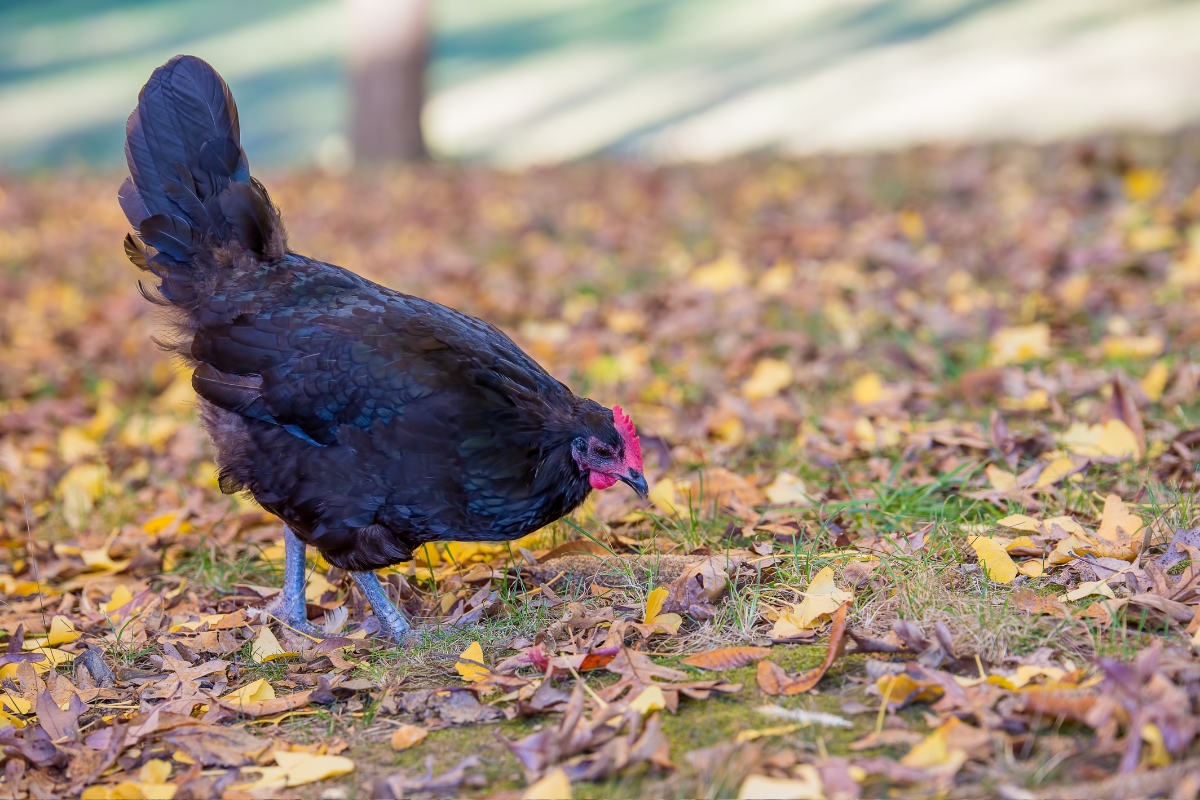
Barnevelder
The Barnevelder chicken traces its roots to the town of Barneveld in the Netherlands, where it was developed in the early 20th century. It was bred from various local Dutch fowl, Asian breeds like the Brahma and Cochins, and possibly some breeds imported from South America. The goal was to create a hardy, dual-purpose bird.
The Barnevelder shines as an egg-layer and source of meat. Barnevelders lay brown eggs, with some strains laying deep, copper-colored eggs. Barnevelders are pretty large chickens that can be butchered from a pretty young age. They’re very productive dual-purpose birds. Not only that, but Barnies are very nice companions and are loved for their calm and friendly disposition. They adapt well to most climates and will lay through the winter! If you’re a first-time owner, a Barnevelder is a great choice, especially if you want a rare heritage breed.
Barnevelder chickens are gorgeous chickens, especially those that have “double-laced” feathers. Each feather has a double outline of dark brown or black around a lighter base color, like chestnut. There are lots of color combinations for a double-laced Barnie–silver, blue, black, white, chamois… The list goes on and on! They have a geometric, U-shaped build, sturdy legs, and a bright red single comb.
- Breed Name: Barnevelder
- Breed Type: Dual-purpose
- Temperament: Friendly, calm, curious
- Size: Hens 5-6 lbs, roosters 7-8 lbs
- Eggs Per Year: 170-200
- Egg Size: Medium to large
- Egg Color: Various shades of brown
- Feather Type: Hard, clean legs
- Comb Type: Single
- Hardiness: Cold hardy and heat tolerant
- Lifespan: 7+ years
- Time To Maturity: 24-30 weeks

Basque
The Basque chicken is (unsurprisingly) from the Basque region of Spain, where it’s also known as the Euskal Oiloa or EO. This breed has a long history, traditionally raised by local farmers for eggs and meat. They were the cornerstone of village communities but were almost put out of business because of the competition it experienced from industrialized breeds. Dr. Fernando Orozco is attributed with trying to preserve the breed by collecting eggs and creating strains, and Dr. Jose Antonio Mendizabal standardized the Basque chicken. Basque chickens have a short history in the US, likely imported around 2005.
The Basque chicken is known to be rugged and adaptable. They’re very confident birds that do well on their own, but they’re very friendly with their owners. Laying up to 250 eggs per year, Basque chickens definitely hold their own when compared to better-known layer breeds. Basques are also fairly large and make a good table bird that produces delicious, flavorful meat. Basques primarily come in two color varieties: red cuckoo (Marraduna) and red (Gorria). Both types have yellow skin, red single combs, and clean legs. Red cuckoo Basques have light barring over their orange-red feathers and black tails, while reds are more uniform red in color with black edges on their tails.
- Breed Name: Basque, Euskal Oiloa, Gallina Vasca, EO
- Breed Type: Dual-purpose
- Temperament: Independent, confident, brave
- Size: Hens 5.5 lbs, roosters 8 lbs
- Eggs Per Year: 200-250
- Egg Size: Medium to large
- Egg Color: Light brown
- Feather Type: Hard, clean legs
- Comb Type: Single
- Hardiness: Heat tolerant
- Lifespan: 7-10 years
- Time To Maturity: 20-24 weeks
Bielefelder
Created in the German town of Bielefeld by a poultry breeder named Gerd Roth, this breed was developed by crossing Malines, Welsummer, and Amrock. The Bielefelder chicken breed quickly gained popularity in Europe and beyond, for good reason. They’re great layers, large table birds, and extremely friendly.
The Bielefelder excels as a dual-purpose breed. Hens are prolific layers of brown eggs, and some Bielefelder hens will lay up to 300 in a year. Bielefelders also have a fast growth rate and are very large, making them an excellent choice as a meat bird. Bielefelders, despite their large size, are perfectly tame and cuddly. They’re easy to handle and perfectly happy wherever they are, whether that be free-ranging or in confinement. Bielefelder hens are very protective of their young, so they make great brooders.
Bielefelder chickens have very unique feather patterns, exhibiting a combination of black, gold, and white. The roosters are particularly eye-catching, and hens typically have more muted coloring. These birds are well-rounded, literally, with hefty bodies, and their feathering provides insulation, making them well-suited for the cold. They’re also fairly heat tolerant, as well.
- Breed Name: Bielefelder (bee-lay-fell-durr)
- Breed Type: Dual purpose
- Temperament: Friendly, docile, protective
- Size: Hens 9.5 lbs, roosters 12 lbs
- Eggs Per Year: 220-300
- Egg Size: Large
- Egg Color: Brown
- Feather Type: Hard, clean legs
- Comb Type: Single
- Hardiness: Cold hardy and heat tolerant
- Lifespan: 7-10 years
- Time To Maturity: 22-24 weeks

Black Sex Link
The Black Sex Link chicken, also known as Black Star or Black Rock, isn’t an APA-recognized breed but a hybrid. It’s the result of crossbreeding a Rhode Island Red rooster and a Barred Plymouth Rock or a New Hampshire Red hen. The Black Sex Link has the name that it has because it’s a sex-linked chicken. When a chick hatches, you can immediately tell if it’s male or female based on the color. This hybrid breed was developed in the United States for its commercial egg-laying capabilities, and it definitely is a powerhouse.
Black Sex Link hens lay tons and tons of large brown eggs, often averaging around 300 eggs per year! To add to their productivity, these chickens are very efficient when converting feed into eggs, making them a popular choice for people who want to profit.
It’s easy to tell a rooster and a hen apart because of their differing feather patterns. The females have solid black feathering, while the males have a barred or speckled black and white pattern. Black Sex Links have a medium-sized build, generally with a sturdy frame and well-rounded bodies, and they have red single combs. Black Sex Links were made to be efficient, and they tend to be relatively low-maintenance.
- Breed Name: Black Sex Link
- Breed Type: Layer
- Temperament: Nervous, flighty, friendly
- Size: Hens 6 lbs, roosters 8 lbs
- Eggs Per Year: Up to 300
- Egg Size: Jumbo
- Egg Color: Brown
- Feather Type: Hard, clean legs
- Comb Type: Single
- Hardiness: Cold and heat tolerant
- Lifespan: 8-10 years
- Time To Maturity: 16-20 weeks
Brahma
Weighing in on average at 10 pounds for roosters and 8 pounds per hen, Brahma chickens are one of the largest chicken breeds. Their big body size makes them ideal as a dual-purpose chicken, raised for meat and eggs.
They have dense feathers and feathered legs, which makes them a great choice for cold climates.
As a docile, easy-going breed, they’re perfect for backyard coops and families, provided you have the coop space to keep such large birds.
- Breed Name: Brahma
- Breed type: Asiatic, dual-purpose (meat and eggs)
- Temperament: Laid-back, docile, confident
- Size: Roosters 10 lbs; Hens 8 lbs.
- Eggs Per Year: 150-200
- Egg Size: Medium
- Egg Color: Brown
- Feather Type: Asiatic, feather-legged
- Comb Type: Pea Comb
- Hardiness: Cold hardy
- Lifespan: 5-8 years
- Time To Maturity: 6-7 months for laying, can be used at 8-10 weeks for meat
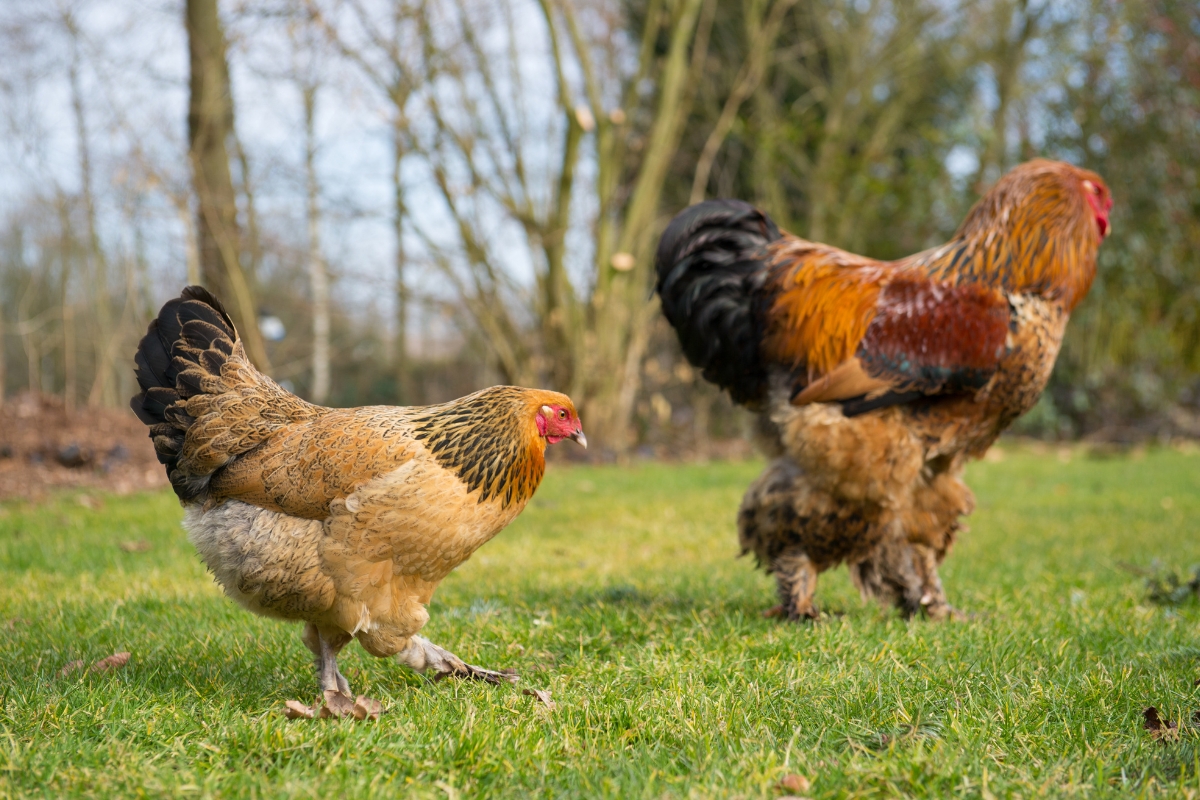
Breda
If you like chickens with a history, consider the Breda. The Breda chicken is a Dutch breed with a lineage dating back to the 1600s. It hails from the city of Breda in the Netherlands and is believed to have been developed from local Dutch fowl combined with Asian breeds like the Cochin, resulting in feathered legs. The Breda’s reach spread through western Europe, especially in France. Historically, Breda chickens were extremely popular in the Breda region, where aristocrats often kept them! Over time, their numbers dwindled as more productive breeds were developed. There were a few attempts to bring the breed back, but they are classified now as rare and endangered.
The Breda chicken is mostly ornamental with the size and egg-laying capacity of a dual-purpose breed. Bredas have a distinctive appearance–they look super tall, with upright postures and snakelike necks. The most common kind of Breda will be iridescent black, but white, splash, cuckoo, and mottled are other colors that the Breda might show. They have a medium-sized build, weighing between 5-7 lbs. Additionally, they have bright red combs and wattles that add a splash of color to mostly monochrome plumage. The Breda is covered from head to toe with heavy feathers, which can be a double-edged sword in the cold. They’re very cold hardy, but they don’t take wetness well.
Bredas are very friendly chickens. Don’t be surprised if your chickens follow you around for attention. They’re super easygoing, which is another reason why Bredas are so popular! If you have the choice to add a Breda to your flock, it’ll fit right into one with mostly docile breeds.
- Breed Name: Breda
- Breed Type: Dual-purpose, ornamental
- Temperament: Calm, docile, friendly
- Size: Hens 5 lbs, roosters 6.5 lbs
- Eggs Per Year: 150-180
- Egg Size: Medium to large
- Egg Color: White
- Feather Type: Hard, feathered legs
- Comb Type: No comb
- Hardiness: Very cold hardy
- Lifespan: 5-10 years
- Time To Maturity: 20-22 weeks
Buckeye
A large-bodied dual-purpose chicken, Buckeyes were bred by Nettie Metcalf in Ohio (thus the name). They’re reputed to be the only breed of chicken developed by a woman, at least in the modern era.
They produce tender meat, and lay up to 250 eggs per year, and are some of the best foragers.
With small pea combs and a large body size, they’re exceptionally cold and hard, too!
- Breed Name: Buckeye
- Breed Type: American, dual-purpose
- Temperament: Active, curious, bold
- Size: Hens 6.5 lbs, roosters 9 lbs
- Eggs Per Year: 150-250
- Egg Size: Large
- Egg Color: Brown
- Feather Type: Standard, clean legs
- Comb Type: Pea comb
- Hardiness: Cold hardy
- Lifespan: 10+ years
- Time To Maturity: 30-32 weeks

Campine
The Campine chicken is one of the rarest breeds of chicken. The Campine is technically one of two Flemish breeds, the other being the Braekel–the only difference is that the Campine originated in the Kempen district, while the Braekel is from the Flanders district. For the sake of clarity, we’ll refer to these collectively as the Campine. They share a common ancestor in Turkish poultry, dating back to the 1500s! Campines were then refined to be a fast-maturing breed with early feathering and fast growth.
Modern Campines are non-broody chickens that lay lots of eggs. They lay up to 200 large white eggs per year. They’re medium-sized, weighing 4 to 6 lbs, and have an athletic frame. Campines are very pretty–they come in shades of silver or gold with black or brown barring across their feathers. They have blue legs, white earlobes, and red combs and wattles–quite the rainbow! You won’t have long to marvel at a Campine, though, because they’re always on the move. These are active fowl that are flighty and energetic. Due to their active nature, they sometimes like to fly over fences, making proper housing with adequate height essential. Health-wise, they are pretty hardy in all temperatures and are amazing foragers.
- Breed Name: Campine
- Breed Type: Continental layer, exhibition, ornamental
- Temperament: Curious, active, flighty
- Size: Hens 5 lbs, roosters 6 lbs
- Eggs Per Year: 140-200
- Egg Size: Large
- Egg Color: White
- Feather Type: Hard, clean legs
- Comb Type: Single
- Hardiness: Heat-tolerant
- Lifespan: 7-10 years
- Time To Maturity: 20-24 weeks

Catalana
One of the most heat-tolerant chicken breeds, Catalana chickens have large combs that help cool them in the heat. They’re originally from Spain, where they were bred for both eggs and meat.
Catalana chickens lay a respectable 200 to 240 eggs a year.
They’re independent, energetic and active, with good foraging ability. They’re a great choice for chicken keepers in hot climates who want a self-sufficient, hands-off breed that still lays plenty of eggs.
- Breed Name: Catalana
- Breed Type: Mediterranean, dual-purpose (meat and eggs)
- Temperament: Energetic, skittish, flighty
- Size: Hens 6 lbs, roosters 8 lbs
- Eggs Per Year: 200-240
- Egg Size: Large
- Egg Color: White, cream
- Feather Type: Standard, clean legs
- Comb Type: Single
- Hardiness: Very heat tolerant
- Lifespan: 5-8 years
- Time To Maturity: 16-20 weeks
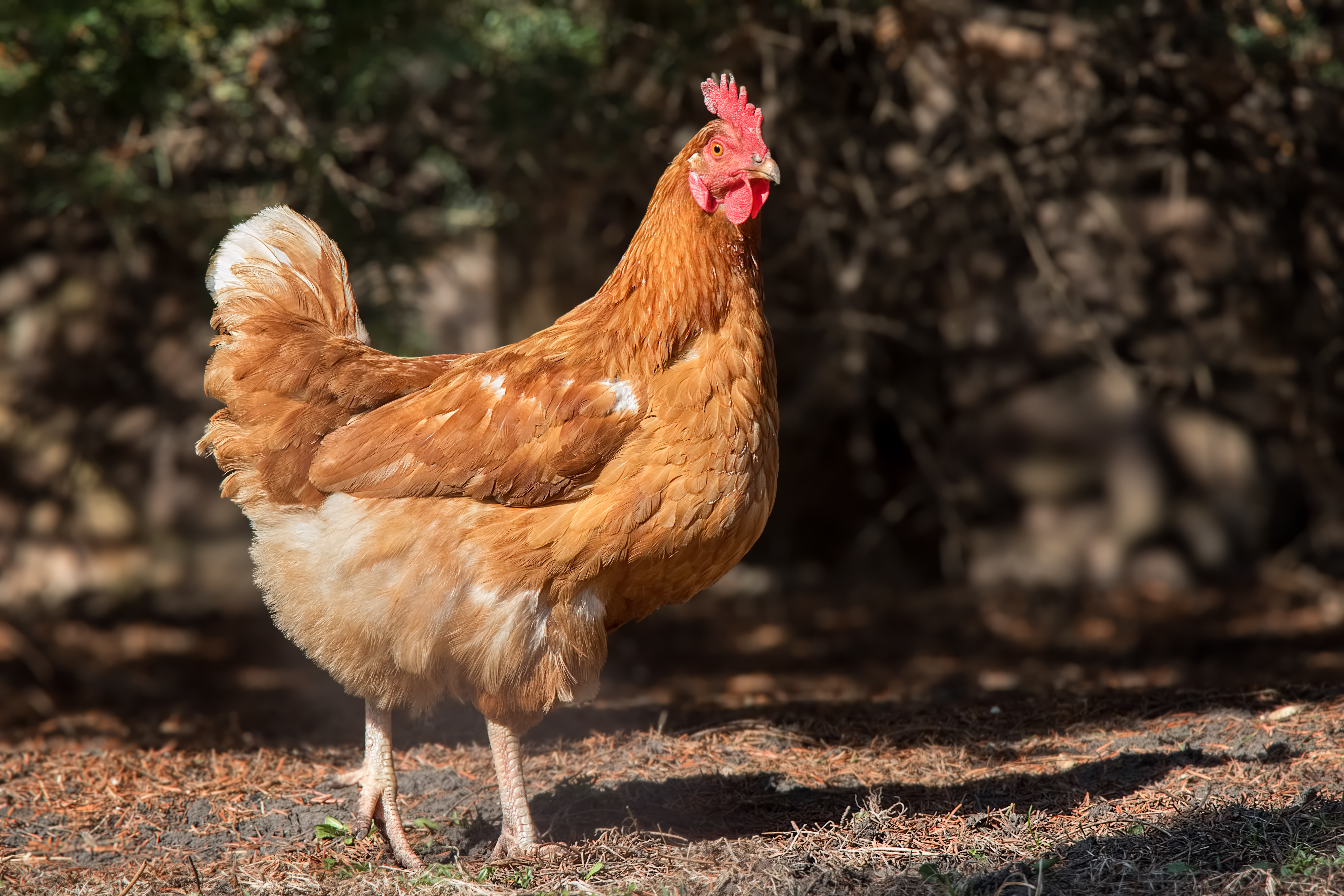
Chantecler
Bred in Canada for their cold hardiness, Chantecler chickens are one of the hardiest, most dependable chicken breeds. They have tiny combs and almost no wattle, which helps prevent frostbite.
These large-bodied chickens are gentle and easy going, with a calm disposition.
In terms of egg laying, they produce a respectable 200 to 240 eggs per year.
Hens are known to go broody, and are good mothers, so they’re also a great choice for a self-sustaining flock.
- Breed Name: Chantecler (shahnt-clair)
- Breed Type: American, dual purpose (meat and eggs)
- Temperament: Intelligent, gentle, calm
- Size: Hens 6.5, roosters 9 lbs
- Eggs Per Year: 200-240
- Egg Size: Medium to large
- Egg Color: Brown
- Feather Type: Standard, clean legs
- Comb Type: Cushion
- Hardiness: Very cold hardy
- Lifespan: 8+ years
- Time To Maturity: 24-30 weeks

Cherry Egger Chicken
The Cherry Egger chicken is a hybrid breed that was developed to lay eggs of a very specific color–cherry-wood brown This hybrid chicken isn’t a standardized breed, meaning it isn’t an APA-recognized breed; there are quite a few strains out there, but the most popular type is distributed by Cackle Hatchery. Cherry Eggers lay lots of large, brown eggs that are supposed to be the color of cherry wood.
The Cherry Egger is valued not only for its egg laying, but for how easy it is to take care of them. They’re known to be pretty friendly. Cherry Eggers are lots of fun to watch, as their curiosity and energy are infectious! Most Cherry Eggers are combinations of reddish-brown, black, white, or other colors. They have red single combs and red wattles. Cherry Eggers are on the larger end of the spectrum when it comes to chicken breeds, weighing between 6-9 lbs, so you’re able to reliably butcher them for a good table bird.
- Breed Name: Cherry Egger
- Breed Type: Dual-purpose
- Temperament: Lively, active, curious
- Size: Hens 6.5 lbs, roosters 8.5 lbs
- Eggs Per Year: Up to 300
- Egg Size: Large
- Egg Color: Light brown
- Feather Type: Hard, clean legs
- Comb Type: Single
- Hardiness: Cold and heat hardy
- Lifespan: 5-10 years
- Time To Maturity: 20-22 weeks
Cochin
Large, easy-going, friendly chickens make some of the best pets, and when you add in fluffy feet and a few extra fluffy layers of feathers, you have attractive, docile, and easy-to-rise cochins.
Considered a dual-purpose bird, for both eggs and meat, cochin chickens grow extra large with roosters topping out at around 11 pounds. They’re not the best layers, but they still do lay a respectable 150 to 180 eggs per year.
Their main claim to fame is their fluffy bodies and friendly dispositions, so they’re a common pet chicken as well.
- Breed Name: Cochin
- Breed Type: Asiatic, dual-purpose (meat and eggs), exhibition
- Temperament: Cuddly, loving, affectionate
- Size: Rooster 11 lbs, hen 8.5 lbs
- Eggs Per Year: 150-180
- Egg Size: Large
- Egg Color: Brown
- Feather Type: Asiatic, feather-legged
- Comb Type: Single
- Hardiness: Cold-hardy
- Lifespan: 8-10 years
- Time To Maturity: 8 months (eggs), 4-16 months (meat)
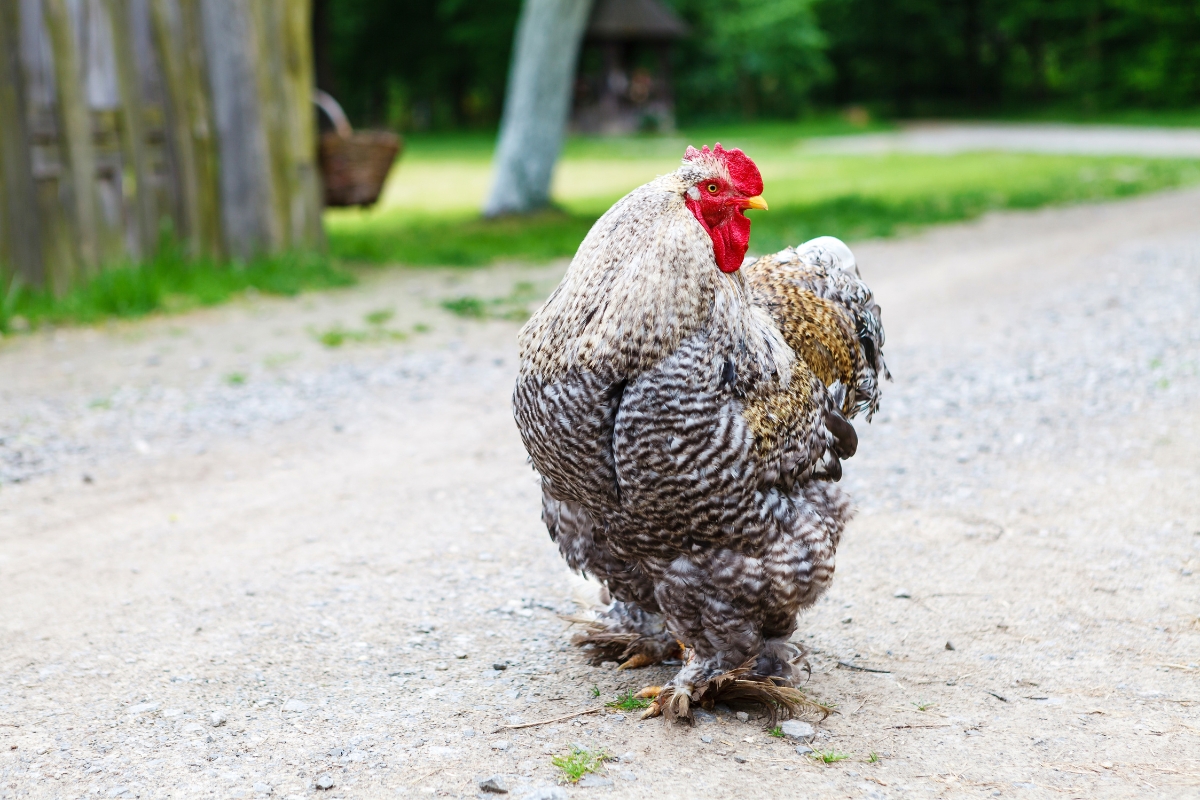
Cream Legbar
Cream Legbars are a hybrid layer breed that produces some of the prettiest eggs you’ll ever see! Cream Legbars are a mix of several different breeds–the White Leghorn, Araucana, and Barred Rock. White Leghorns are prolific layers. Barred Rocks are also great layers and are very hardy and docile. Araucanas lay blue eggs. The combination of these made the Legbar an amazingly productive breed that lays tons of gorgeous, light blue or green eggs! Cream Legbars are autosexing, so you can tell the females from males as soon as they hatch, since they’ll have different feather patterns. A female Legbar chick has dark stripes on her back, while male Legbar chicks have much lighter stripes.
Cream Legbars are cream-colored, covered in dappled and barred feathers. Cream Legbar hens and roosters are easy to tell apart, as females have more dark gray feathers on their back than males, which have more cream. Cream Legbars have red single combs, white or yellow earlobes, and yellow legs. To give them a bit more personality in appearance, Cream Legbars have a crest of feathers around their combs, like a mohawk.
Cream Legbars are an amazing choice if you’re looking for a chicken that lays heaps of blue eggs. Not to mention that they’re docile and easy to raise! Most Cream Legbars are easygoing and get along well with other chickens. They retain the energy and curiosity of their Leghorn forebears, so they do best as free-rangers. In general, Cream Legbars are healthy and hardy, but they much prefer the heat to the cold.
- Breed Name: Cream Legbar
- Breed Type: Layer
- Temperament: Independent, active, curious
- Size: Hens 5.5 lbs, roosters 7.5 lbs
- Eggs Per Year: Up to 300
- Egg Size: Large
- Egg Color: Light blue or green
- Feather Type: Hard, clean legs, head crest
- Comb Type: Single
- Hardiness: Heat-tolerant
- Lifespan: 5-10 years
- Time To Maturity: 21-25 weeks
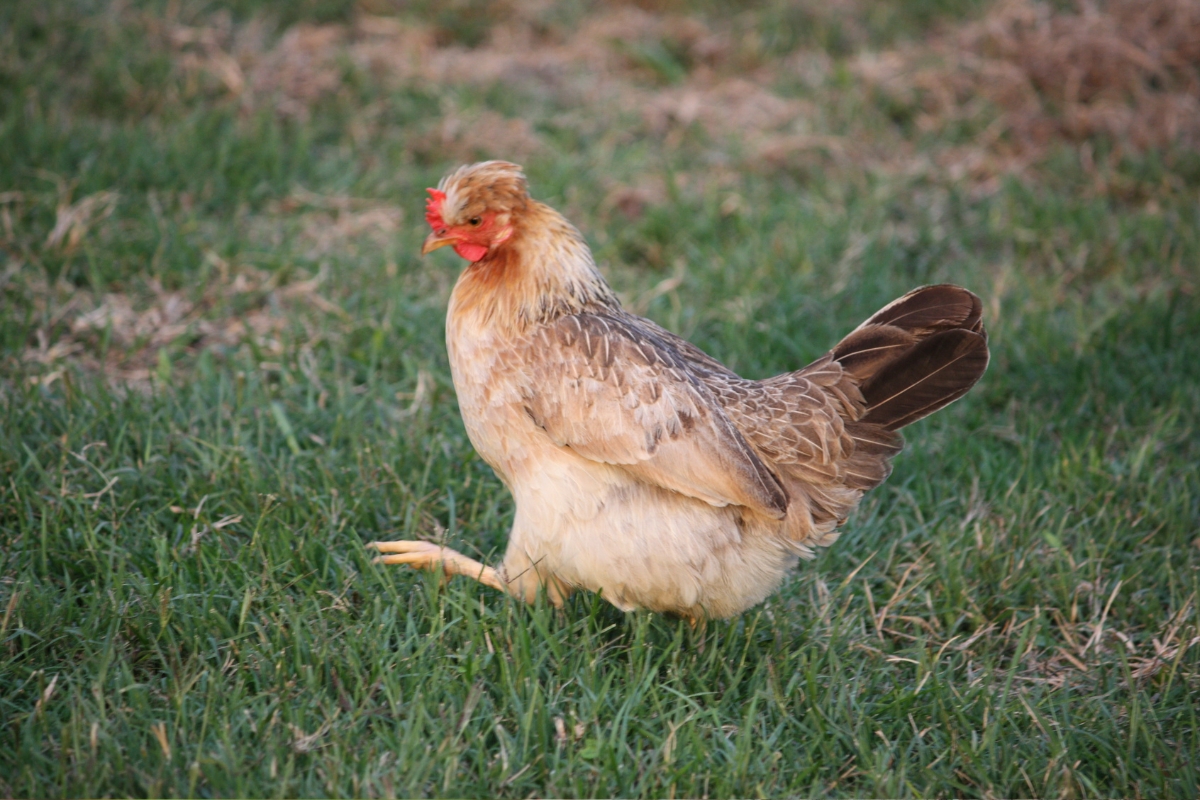
Delaware
A dual-purpose chicken, but more commonly raised for meat, Delaware chickens are cold, hardy, and friendly birds that lay jumbo-sized eggs.
With a good-sized body, they also produce plenty of tender, delicious meat when raised as a broiler. In general, they’re active, alert, and predator-aware, making them a great alarm bird to help safeguard a mixed flock.
This particular breed does well in both confinement and as a free-range chicken.
- Breed Name: Delaware
- Breed Type: American, dual-purpose (meat and eggs)
- Temperament: Active, lively, friendly
- Size: Hens 6 lbs, roosters 8 lbs
- Eggs Per Year: 150-200
- Egg Size: Large
- Egg Color: Light brown
- Feather Type: Standard, clean legs
- Comb Type: Single
- Hardiness: Cold hardy
- Lifespan: 5+ years
- Time To Maturity: 18-20 weeks
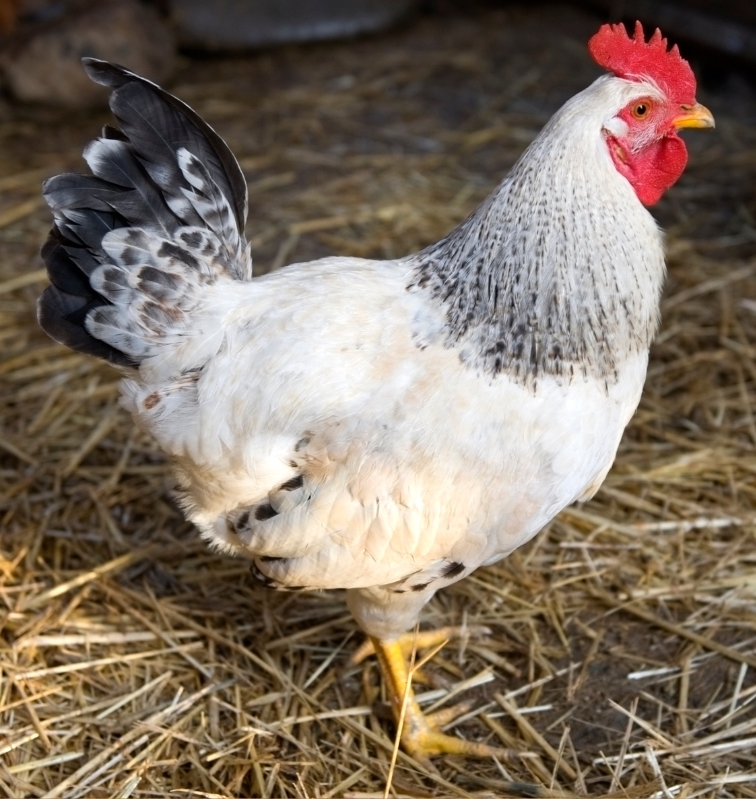
Dominique
First bred in Colonial America, this is one of the country’s oldest chicken breeds. They’re known for extreme cold hardiness, as well as independence and good foraging abilities.
This breed knows how to take care of itself, and can be a bit aggressive towards other more docile breeds.
In general, they’re usually quite friendly toward humans (even if they don’t do well with some other chicken breeds).
- Breed Name: Dominique
- Breed Type: American, dual-purpose (meat and eggs)
- Temperament: Calm, alert
- Size: hens 5 lbs, roosters 7 lbs
- Eggs Per Year: 200-280
- Egg Size: Medium to large
- Egg Color: Light brown
- Feather Type: Standard, clean legs
- Comb Type: Rose comb
- Hardiness: Cold hardy and heat tolerant
- Lifespan: 8+ years
- Time To Maturity: 21-24 weeks
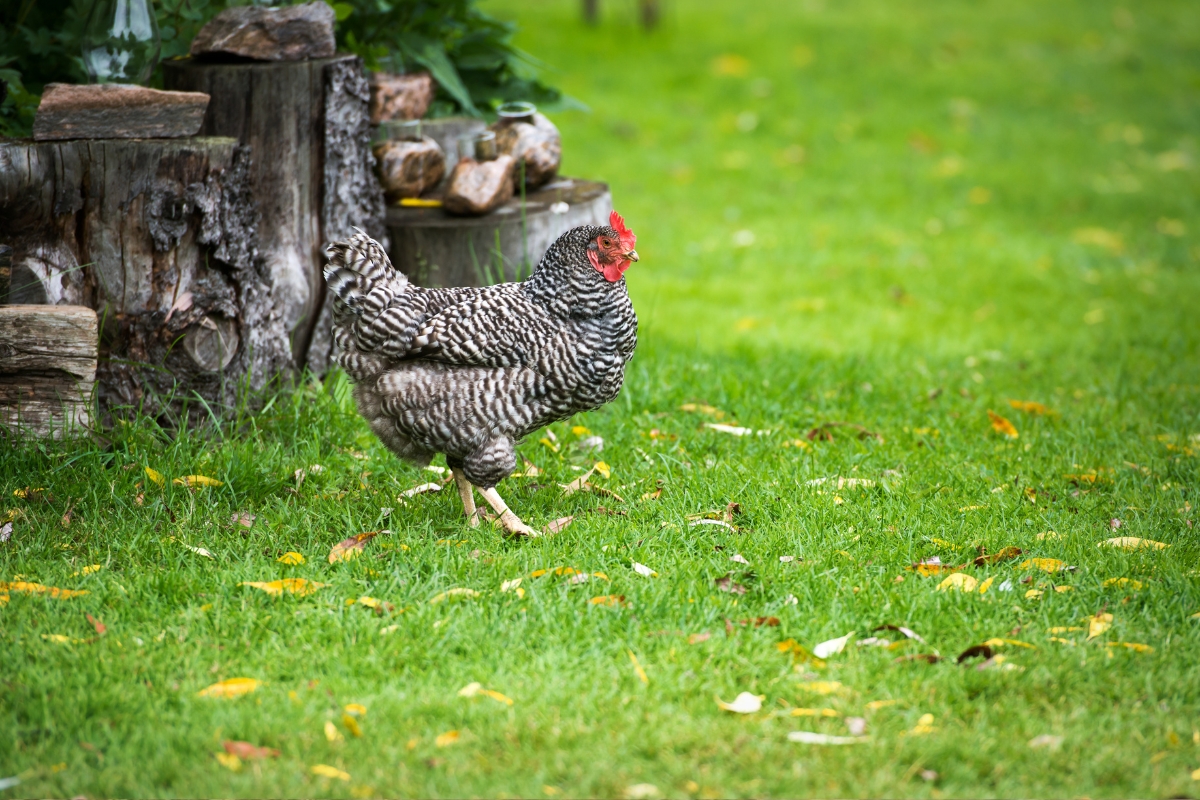
Dorking
Often kept as a large-bodied meat chicken, Dorkings also lay plenty of eggs, making them an excellent dual-purpose chicken breed.
They’re an old breed, originally raised in ancient Rome, and they were once the most popular meat chicken breed in England. They have wonderful meat, that’s tender and juicy, and many keepers of this breed boast that no other chicken tastes quite as good.
A slow-moving, and generally lazy bird, they do well in confinement and are prone to overeating. They’re also very cold-hardy, as well as heat tolerant.
- Breed Name: Dorking
- Breed Type: Dual-purpose (meat and eggs)
- Temperament: Calm, gentle, affectionate
- Size: Hens 7 lbs, roosters 9 lbs
- Eggs Per Year: 170-190
- Egg Size: Large
- Egg Color: White, cream
- Feather Type: Hard, clean legs
- Comb Type: Single or rose
- Hardiness: Heat tolerant, cold hardy (watch the wattle for frostbite)
- Lifespan: 5-8 years
- Time To Maturity: 26-30 weeks
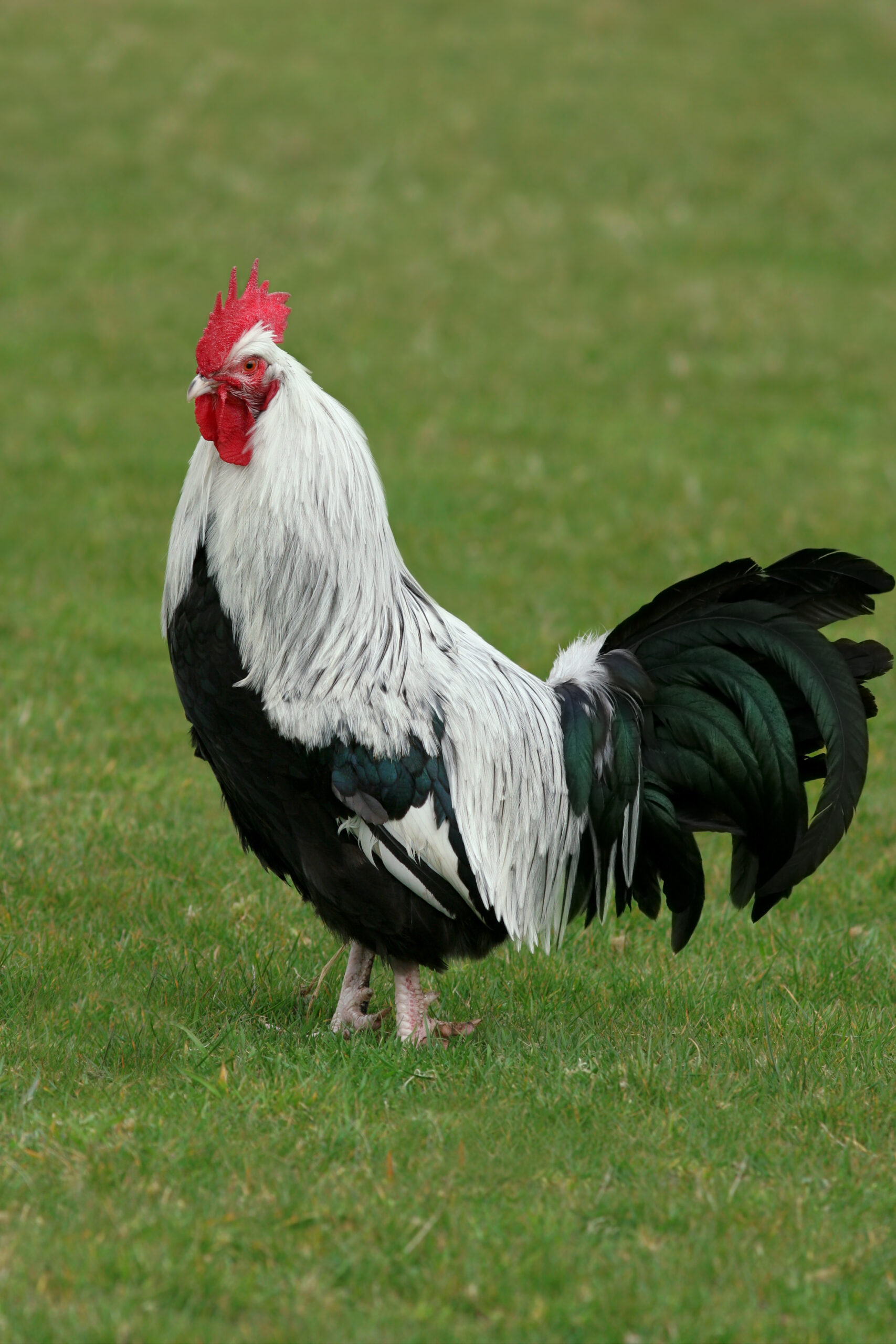
Easter Egger
Though they’re not a true “chicken breed,” easter eggers are becoming more common from hatcheries every year. They’re a cross breed that lays blue green eggs, and they come in all manner of feather colors.
The personality characteristics depend on the parent breeds, but generally they’re friendly and assertive, and they are healthy, robust birds that tolerate both heat and cold.
You can expect 200 to 250 eggs a year in ideal conditions.
- Temperament: Friendly, curious, vibrant
- Size: Medium, four to five pounds
- Eggs Per Year: 200 to 250
- Egg Size: Large
- Egg Color: Varies widely (Whatever color your hen lays will be her egg color. Each can lay a different color.)
- Hardiness: Cold Hardy and Heat Tolerant
- Lifespan: Four to seven years
- Time To Maturity: 20 to 24 weeks
The benefits of Easter Eggers Include:
- Good Foragers
- Friendly, active personalities
- Variety of Feather and Egg Colors
- Good egg production
The downsides of Easter Eggers Include:
- Not a standard breed, so high variability
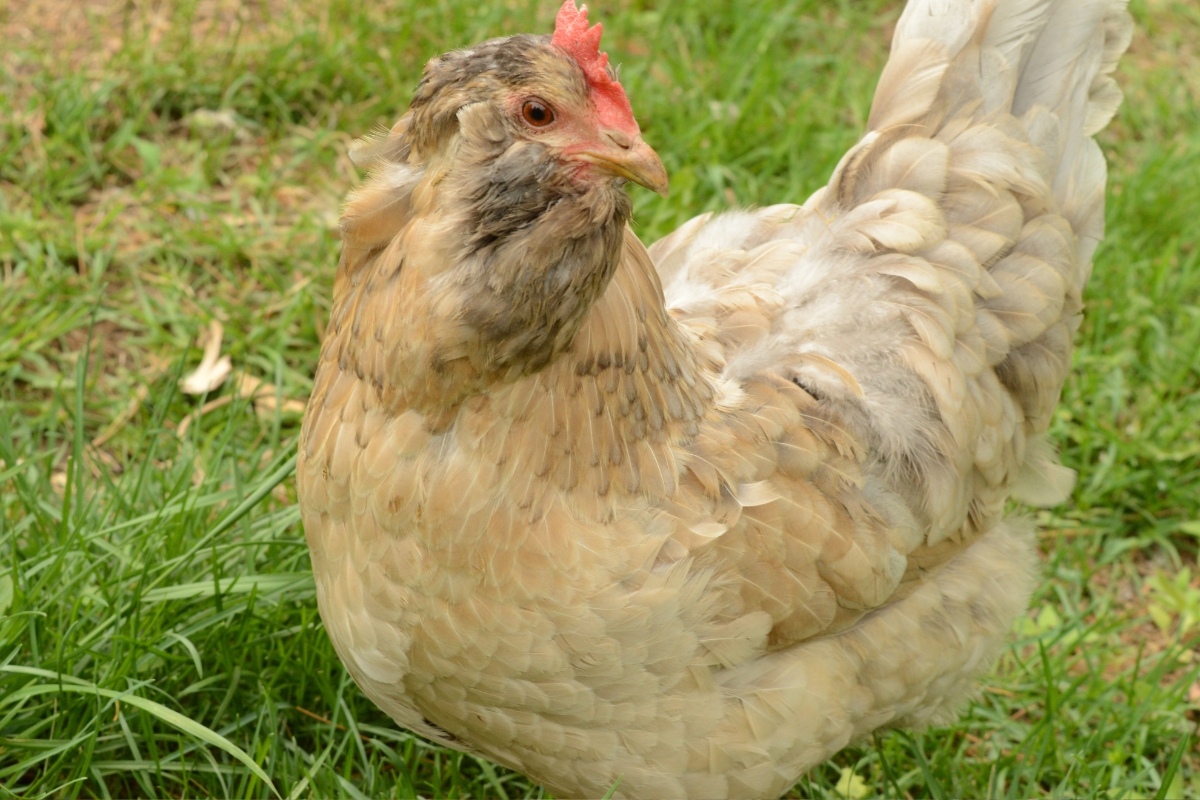
Faverolles
Known for their fluffy feathers and salmon-cream-colored eggs, faverolle chickens are a favorite backyard chicken for homesteaders and suburban households just about everywhere. They have attractive fluffy muffs and feathered legs, which help keep them warm in cold climates, but they’re also heat tolerant.
They lay around 180 to 240 eggs a year, but there’s still quite a bit of variability in the breed.
- Breed Name: Faverolles (fav-roll)
- Breed Type: Ornamental, eggs, meat
- Temperament: Active, friendly, docile
- Size: Roosters 8 lbs, hens 6.5 lbs
- Eggs Per Year: 180-240
- Egg Size: Medium
- Egg Color: Cream, white
- Feather Type: Continental, muffs, feather-legged
- Comb Type: Single
- Hardiness: Heat-tolerant and cold-hardy
- Lifespan: 5-7 years
- Time To Maturity: 19 weeks
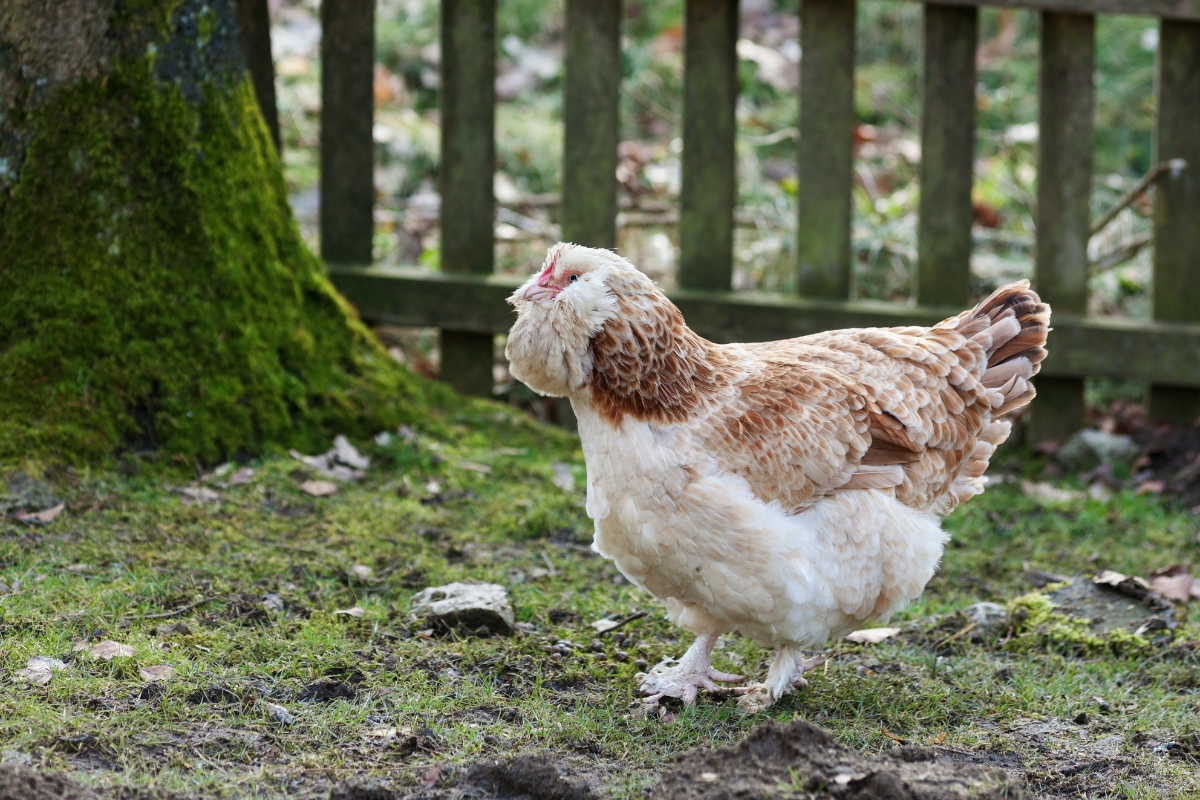
Hamburg
The Hamburg chicken had many names throughout history: Pheasant Fowl, Pheasants, Yorkshire Pheasant, and Silver Pheasant-Fowl of Yorkshire, among others. And its history is pretty confusing–while their name suggests that they’re from Germany, Hamburgs might be the descendants of Mediterranean and Middle Eastern chickens. What’s known for sure is that they’ve always had a very loyal following, especially in England.
The Hamburg lays an upwards of 220 small to medium white eggs per year. While they used to be used for commercial egg production, their role in the industry has dwindled with the rise of more efficient hybrids. Today, they’re mainly kept for the beauty they add to backyard flocks. One look at a Hamburg and you’ll see why. Hamburgs come in a few different color varieties, like spangled and gold- and silver-penciled. They have a small rose comb and bright red wattles and earlobes. I think the eyes of Hamburgs are especially captivating–they’re so round, dark, and bright!
Hamburgs are a look-don’t-touch breed that don’t like to be handled. They’re a bit standoffish and won’t back down from a fight. Their active nature makes them great free-rangers, and they value being able to explore and wander. Overall, Hamburgs are very hardy with few health problems that you need to be aware of.
- Breed Name: Hamburg
- Breed Type: Layer
- Temperament: Assertive, active, brave
- Size: Hens 4 lbs, roosters 5 lbs
- Eggs Per Year: 200-220
- Egg Size: Medium
- Egg Color: White
- Feather Type: Hard, clean legs
- Comb Type: Rose
- Hardiness: Cold hardy
- Lifespan: 8+ years
- Time To Maturity: 20-25 weeks
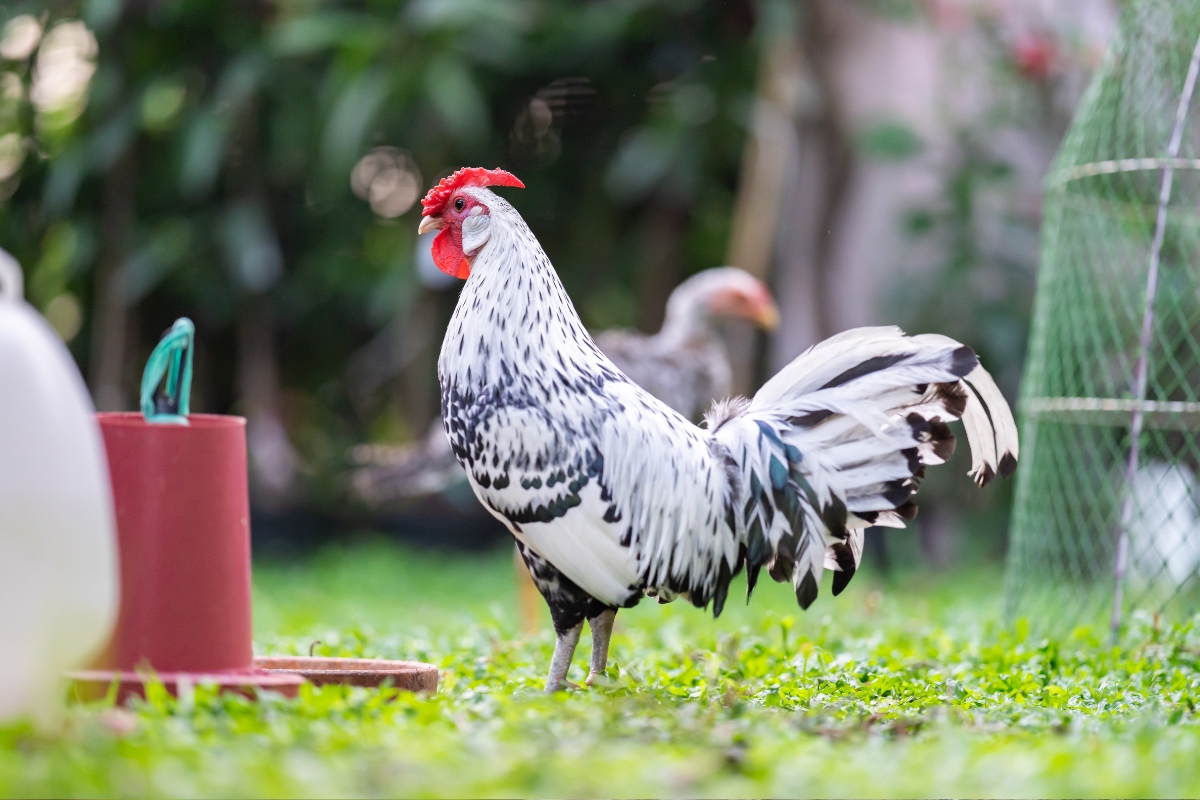
Icelandic
A rare breed, and the only chicken breed to originate in Iceland, the Icelandic chicken is a special bird. They trace their lineage all the way back to the 10th century, and they’re especially well adapted to harsh, cold climates.
They’re independent and alert to danger, as they were bred to fend for themselves mostly.
- Breed Name: Icelandic
- Breed Type: All other, layer
- Temperament: Active, flighty, energetic
- Size: Females 3 lbs, males 5 lbs
- Eggs Per Year: 180
- Egg Size: Medium
- Egg Color: Light brown, white, cream
- Feather Type: Standard, clean legs
- Comb Type: Varies (rose, single, pea all possible)
- Hardiness: Very cold hardy, heat tolerant
- Lifespan: 10+ years
- Time To Maturity: 20-22 weeks
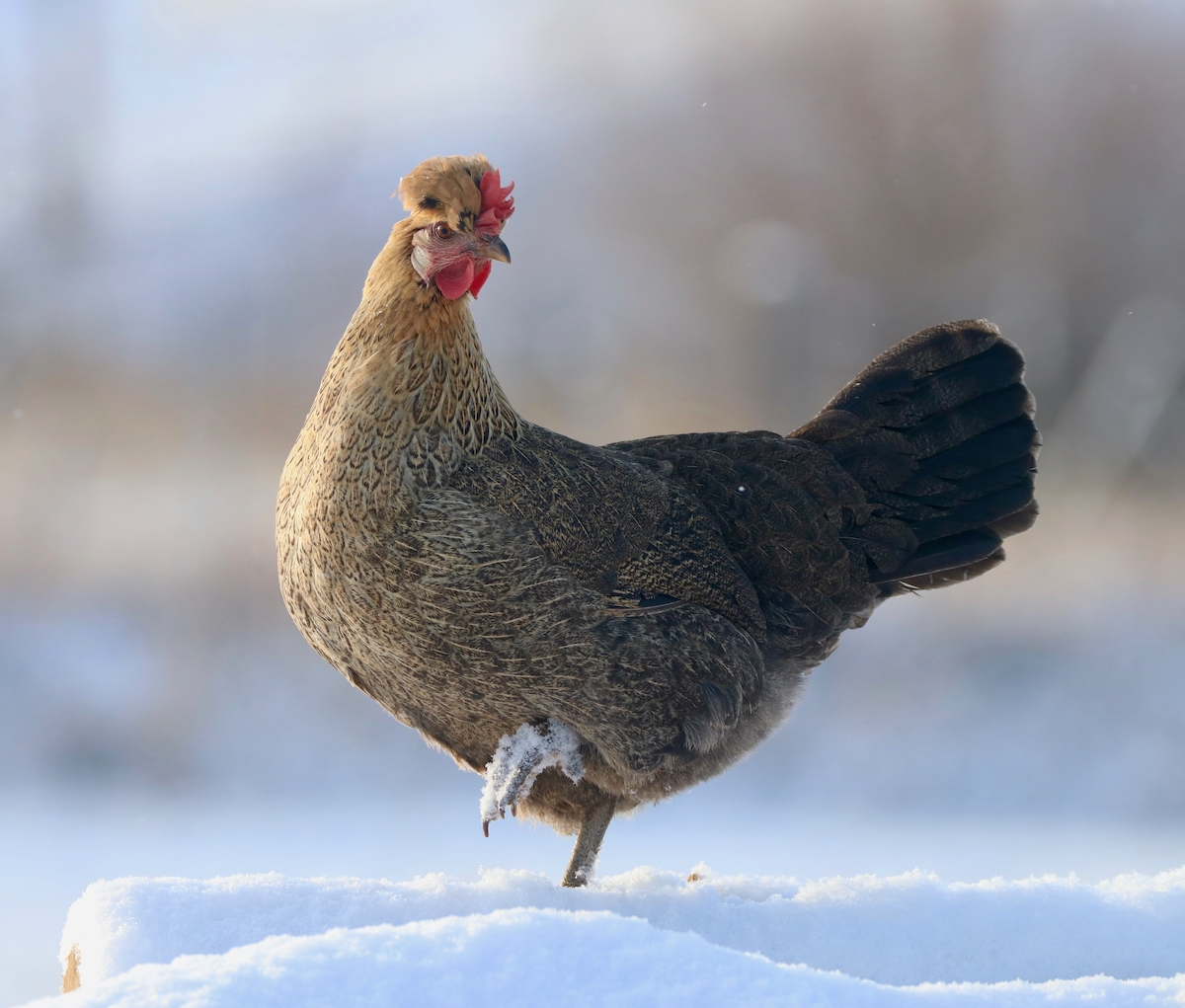
Iowa Blue
The Iowa Blue chicken comes from–you guessed it–Iowa! The state takes much pride in this American heritage breed. The exact lineage of the Iowa Blue is a bit muddy, but it’s most likely the result of crossing Javas, Plymouth Rocks, and other local chickens. The breed was initially selected for its hardiness, adaptability to harsh climates, and efficient egg-laying abilities, primarily in farmyard settings across the Midwest.
The Iowa Blue is a hardy dual-purpose breed. They lay 200-250 large brown eggs per year–not bad for a bird that can be used for meat! Looking at an Iowa Blue, you’ll see that these are medium-sized chickens with nice, full bodies. They weigh between 6-8 lbs, so large enough to be a good table bird. The Iowa Blue isn’t actually blue, despite what the name implies. They have white heads and brown or black bodies with penciling.
Iowa Blue owners can speak to the spunkiness of this breed. Iowa Blues are unbelievably brave and protective of their flock–some accounts say that they’ll take on hawks and cats! They’re calm around people but are keenly aware of danger. The Iowa Blue is tough and happy to live in the heat or cold. They’re powerful pest killers, too. What an Iowa Blue doesn’t like is being cooped up, so make sure they have plenty of room to roam.
- Breed Name: Iowa Blue
- Breed Type: Dual-purpose
- Temperament: Brave, confident, protective
- Size: Hens 6 lbs, roosters 8 lbs
- Eggs Per Year: 200-250
- Egg Size: Large
- Egg Color: Brown
- Feather Type: Hard, clean legs
- Comb Type: Single
- Hardiness: Cold hardy, and heat tolerant
- Lifespan: 5-7 years
- Time To Maturity: 22-25 weeks
Isbar
Who doesn’t love a colorful basket of eggs? Green eggs are especially rare in a non-crossbreed chicken, and the Isbar rises up to the task. The Silverudd’s Isbar, referred to here as the Isbar, was developed in Sweden during the 20th century by a farmer named Martin Silverudd, who wanted a cold-hardy dual-purpose breed that could lay colorful eggs. It’s likely that he used Rhode Island Reds, New Hampshires, and Cream Legbars to create the Isbar. The Isbar breed isn’t an APA-recognized breed, nor did Silverudd care about standardizing it, resulting in a breed that’s wonderfully diverse and hardy.
The most obvious reason you’d want an Isbar is its ability to lay green eggs. Hens lay medium to large-sized eggs with shells that come in shades of green. They lay a good number of eggs, between 200 to 230, each year. They’re medium-sized birds that don’t get terribly large, though, so you’re better off keeping them as layers instead of meat.
Isbars have a lot of variation in appearance. They all have red combs and wattles. They come in a few different colors. Black Isbars have uniformly black feathers. Splash Isbars are white with patches of black. The Blue Isbar is the most popular, which is a solid light to dark blue. Isbars are spritely, active birds that love people. They’re really friendly, but the roosters are very protective of their flock. Isbars are a hardy breed that thrive in the cold and are amazing foragers.
- Breed Name: Isbar (ice-bar), Silverudd’s Blue, Silverudd’s Isbar
- Breed Type: Layer
- Temperament: Friendly, gentle, curious
- Size: Hens 4.5 lbs, roosters 5.5 lbs
- Eggs Per Year: 200-230
- Egg Size: Large
- Egg Color: Green
- Feather Type: Hard, clean legs
- Comb Type: Single
- Hardiness: Cold hardy
- Lifespan: 6-10 years
- Time To Maturity: 20-24 weeks

Java
Generally raised for meat, Java chickens are large-bodied, and their meat has exceptional flavor. They were originally bred from other modern-day meat breeds, including Plymouth Rock.
They grow more slowly than most meat breeds, but those who choose to raise them emphasize meat quality rather than feed conversion.
They are good at foraging, which will cut down on feed costs somewhat.
- Breed Name: Java
- Breed Type: Dual purpose (meat and eggs)
- Temperament: Calm, alert, friendly
- Size: Hens 7.5 lbs, roosters 9.5 lbs
- Eggs Per Year: 150-180
- Egg Size: Medium to large
- Egg Color: Brown
- Feather Type: Hard, clean legs
- Comb Type: Single
- Hardiness: Heat-tolerant
- Lifespan: 5-8 years
- Time To Maturity: 30-34 weeks
Jersey Giant
One of the very largest chicken breeds, with roosters topping out at around 13 pounds, Jersey Giants are excellent dual purpose birds. They lay a respectable 150 to 200 eggs a year, and mature relatively fast given their large body size.
Jersey Giants aren’t particularly active, so they do reasonably well in confinement, but they’re also fine free-ranging. They have a gentle easy-going personality that works well in mixed flocks too.
They’re friendly and docile, so they’re a great choice for backyard homesteaders.
- Breed Name: Jersey Giant
- Breed Type: American, dual-purpose (meat and eggs)
- Temperament: Easygoing, calm
- Size: Hens 10 lbs, roosters 13 lbs
- Eggs Per Year: 150-200
- Egg Size: Large
- Egg Color: Brown
- Feather Type: Standard, clean legs
- Comb Type: Single
- Hardiness: Cold hardy
- Lifespan: 6-10 years
- Time To Maturity: 18-20 weeks
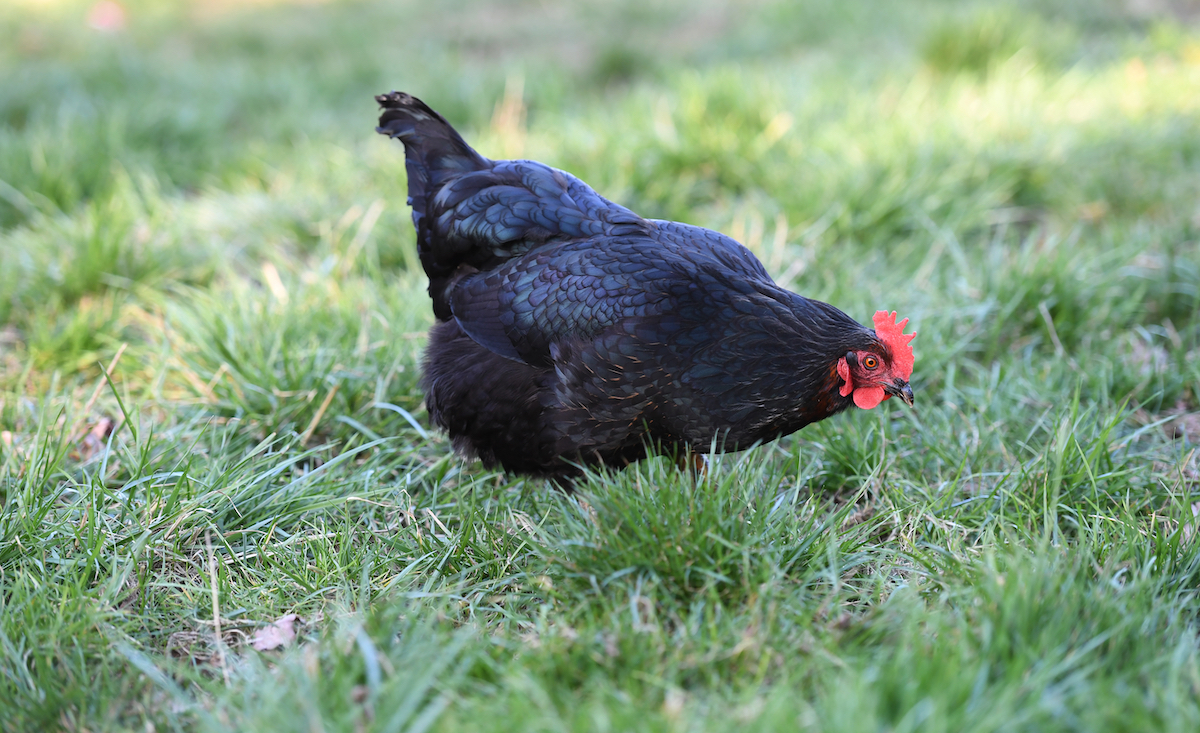
Langshan
The Langshan chicken might be one of the oldest breeds to exist, with historical accounts dating back hundreds and hundreds of years. Believed to have originated in China in the Langshan region, the Langshan might have been developed from local chickens and then crossed with large breeds like Cochins or Brahmas. Langshans were first imported to England in 1872 in the midst of the British craze for Asian chickens. While not as popular in the west as Brahmas and Cochins, Langshans have always had a loyal following.
Langshans are a great dual-purpose breed, used for meat and eggs. Langshans are on the larger side at 7-9 lbs, and make quite a tasty table bird. Langshans also lay plenty of medium to large brown eggs, averaging around 150 to 200 eggs per year. Some Langshans lay dark brown eggs that have a bluish tinge. Their calm and friendly personality makes them excellent companions, too–this bird does it all!
Langshan chickens have a very large body, although not as big as their Asiatic-breed cousins, covered in soft feathers. They stand tall with impressive bulk. The Langshan has lustrous black plumage with a greenish sheen, a single comb and bright red wattles. Health-wise, Langshans are pretty hardy birds, but there are a few things to be aware of–they have lightly feathered feet that can be prone to frostbite. Langshans are also notoriously good at flying, so their space will have to be carefully constructed.
- Breed Type: Asiatic, dual-purpose (meat and eggs)
- Temperament: Docile, calm, easygoing
- Size: Roosters 9.5 lbs, hens 7.5 lbs
- Eggs Per Year: 150-200
- Egg Size: Large
- Egg Color: Dark brown
- Feather Type: Standard with feathered legs
- Comb Type: Single
- Hardiness: Hardy, especially in heat
- Lifespan: 8+ years
- Time To Maturity: 5-7 months
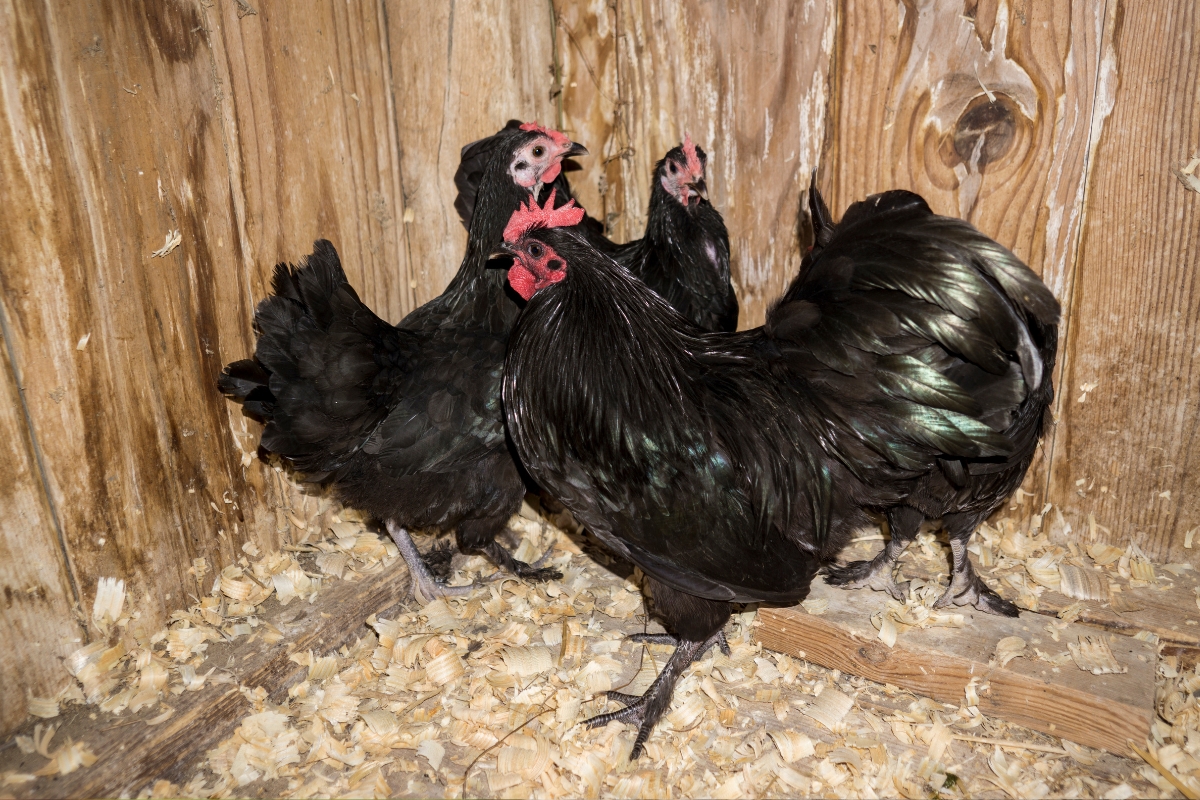
Leghorns (White and Brown)
One of the most common commercial chicken breeds, Leghorn chickens are excellent egg layers, producing around 300 eggs per year. They’re not the friendliest birds and are often aggressive to other, more timid birds in the coop. As a result, they don’t do well in mixed flocks, and it’s best to keep this breed alone, knowing that each bird will find its place in the pecking order and then hold its own.
They’re from Italy and do well in hot and dry environments, but they are adaptable enough to tolerate moderately cold climates too.
Nervous and slightly, this bird won’t be snuggling up to its keeper, but it is still an excellent dual-purpose breed that works well for hands-off chicken keepers.
- Breed Name: Leghorn
- Breed Type: Mediterranean, dual-purpose (meat and eggs)
- Size: Hens 5 lbs, roosters 7.5 lbs
- Personality: Active, flighty, loud
- Eggs per year: 280-320
- Egg color: White
- Hardiness: Heat-tolerant
- Comb type: Single
- Feather type: Standard, clean legs
- Lifespan: 5-7 years
- Time to Maturity: 18-20 weeks
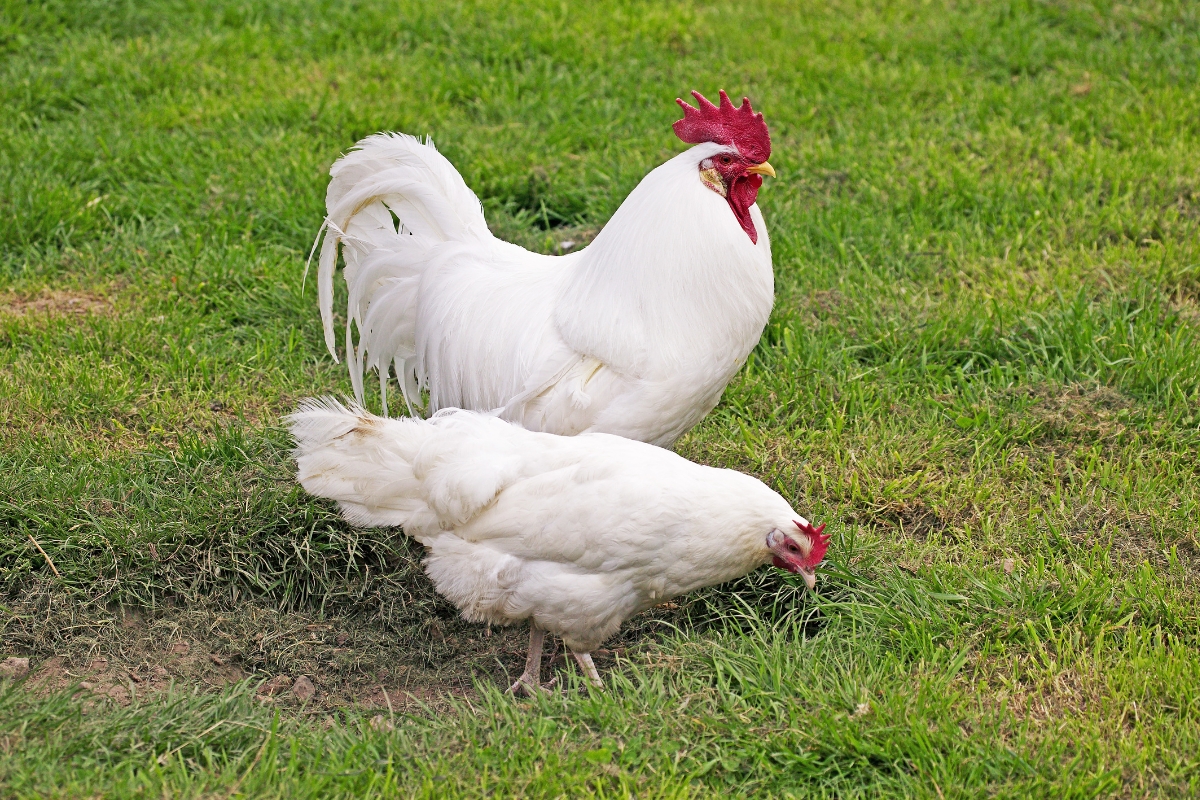
Marans
There are a number of different color variations of Marans chickens, but the black copper Marans are some of the most common. This extra fluffy chicken breed is known for their strikingly beautiful appearance, as well as the dark brown eggs they lay.
They’re considered a medium-bodied dual-purpose bird that works well in mixed flocks.
- Breed Type: Continental, dual-purpose (meat and eggs)
- Temperament: Friendly, gentle
- Size: hens 6 lbs, roosters 8 lbs
- Eggs Per Year: 150-200
- Egg Size: Large
- Egg Color: Dark brown
- Feather Type: Standard, with trim muffs and clean legs (some feathered legs too)
- Comb Type: Single
- Hardiness: Cold hardy and heat tolerant
- Lifespan: 7-8 years
- Time To Maturity: 20 to 24 Weeks
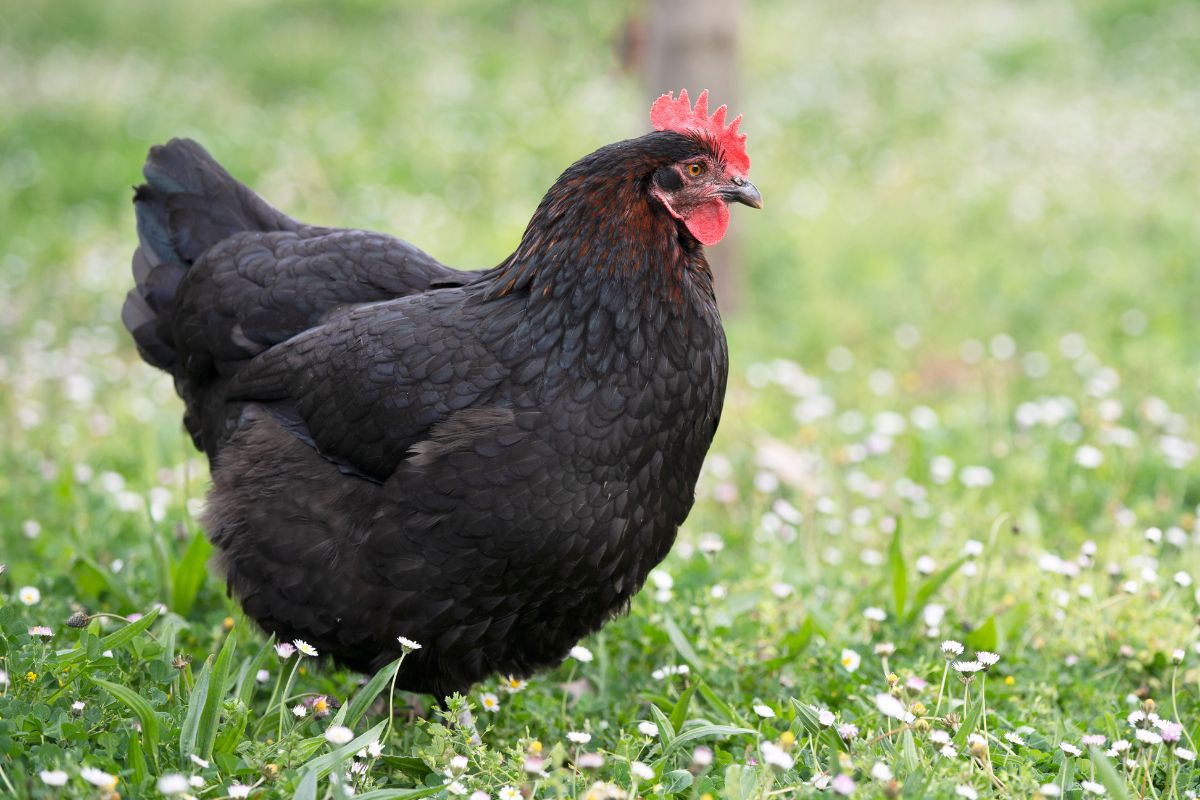
Minorca
One of the best meat chickens for hot climates, the Minorca is a large Mediterranean breed that reaches 7 1/2 to 9 pounds at maturity. It produces lean meat without a lot of fat, which is what many people look for in chicken these days.
Though not heavy layers, they still produce 140 to 200 eggs a year, making them an excellent dual-purpose chicken for hot regions.
- Breed Name: Minorca
- Breed Type: Mediterranean, dual-purpose
- Temperament: Active
- Size: Hens 7.5 lbs, roosters 9 lbs
- Eggs Per Year: 140-200
- Egg Size: Jumbo
- Egg Color: White
- Feather Type: Standard, clean legs
- Comb Type: Single
- Hardiness: Heat-tolerant
- Lifespan: 6-8 years
- Time To Maturity: 20-26 weeks
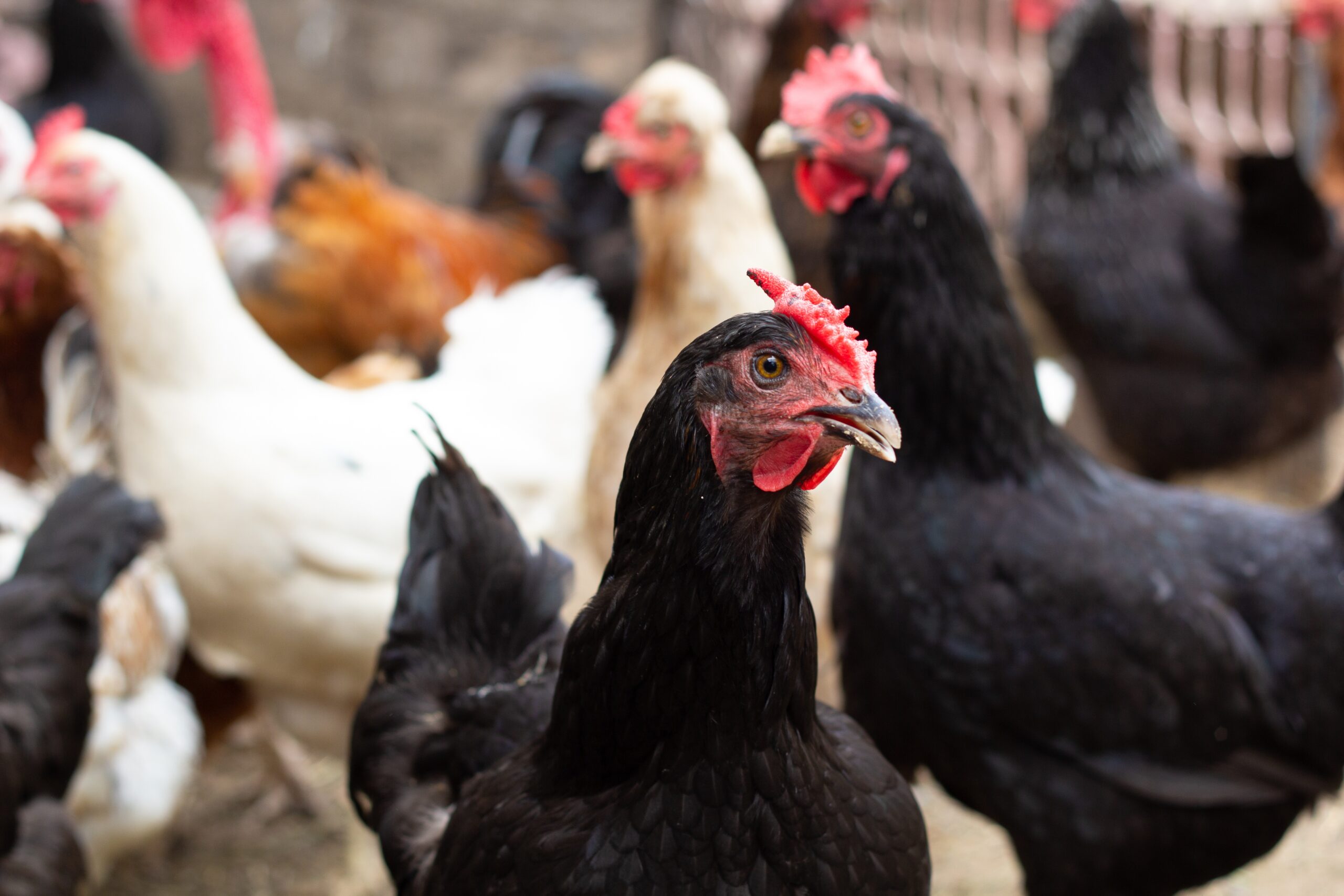
Niederrheiner
The Niederrheiner chicken comes from the Lower Rhine region of Germany. It’s likely that the Niederrheiner was developed from local landrace chickens, primarily the Dutch North Holland Blue, and was bred to thrive in the Lower Rhine’s climate and terrain, making this a very hardy breed. The Niederrheiner was originally created to be a meat bird, but with the number of eggs it lays per year, it’s best known now as a dual-purpose breed.
The Niederrheiner lays 150-200 medium to large brown eggs per year. What makes them even better as layers is that hens aren’t broody. Niederrhiners also produce lots of flavorful meat; their size of 7-9 lbs is definitely not small. To top it all off, Niederrheiner chickens are very docile and friendly, making them an amazing addition to your flock. They’re easily handled and love people.
The Niederrheiner comes in a few different colors, with some developed as recently as the last few years. These colors are silver, lemon cuckoo, blue cuckoo and birchen. They have a single comb and bright red wattles. Feather patterns in Niederrheiners can vary, depending on the variety. Niederrheiners don’t have specific health concerns unique to their breed. They’re very robust and healthy, needing little maintenance.
- Breed Name: Niederrheiner (need-urr-rine-urr)
- Breed Type: Dual-purpose
- Temperament: Friendly, calm, docile
- Size: Hens 7 lbs, roosters 9 lbs
- Eggs Per Year: 150-200
- Egg Size: Large
- Egg Color: Brown
- Feather Type: Hard, clean legs
- Comb Type: Single
- Hardiness: Cold and heat-tolerant
- Lifespan: 8+ years
- Time To Maturity: 20-22 weeks
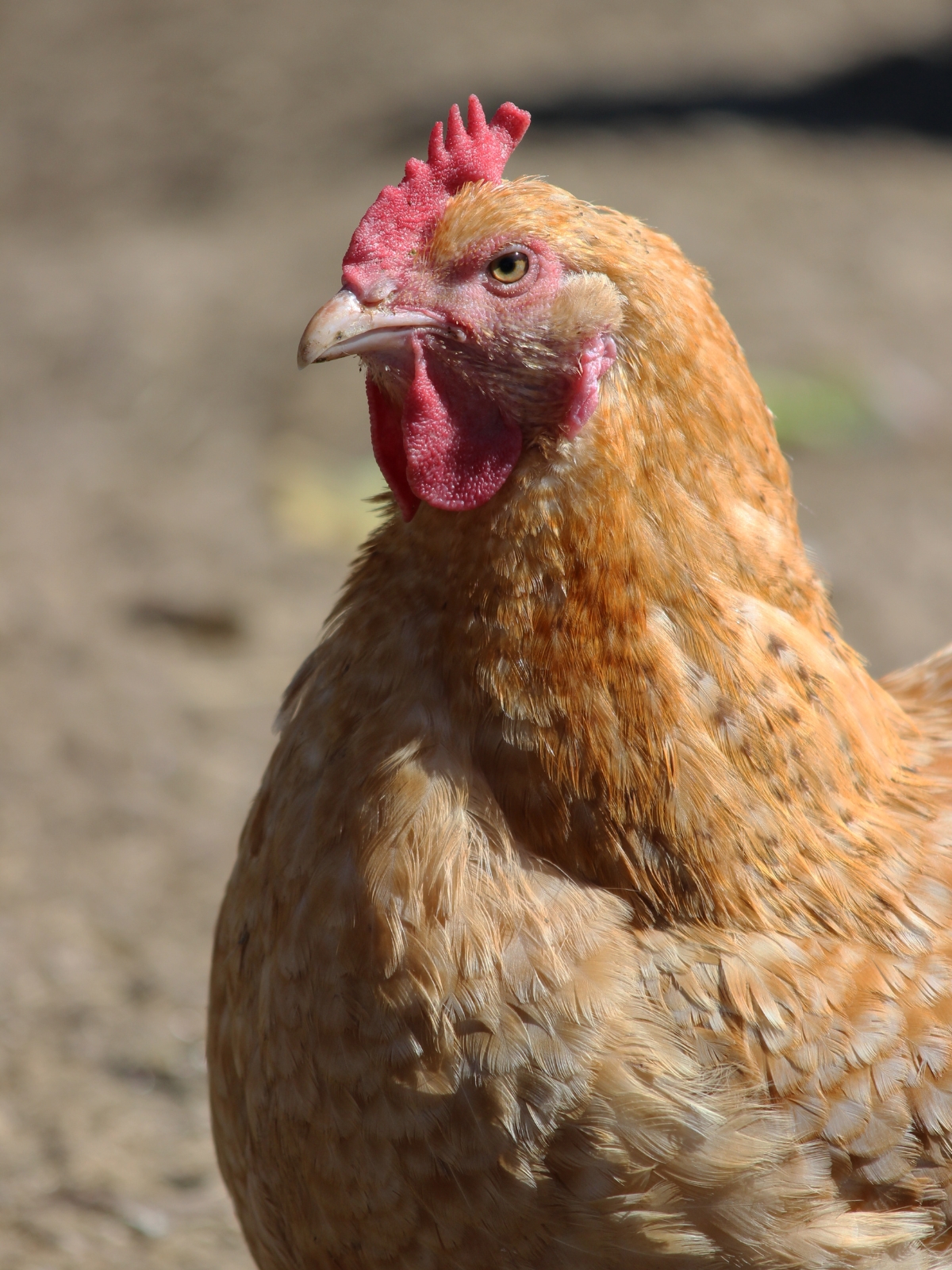
New Hampshire
Also called “New Hampshire Red” this breed is quite similar to Rhode Island Red chickens, but with extra cold hardiness.
These dual purpose birds are raised for both eggs and meat, and they lay an impressive 200 to 250 eggs per year. They also produce a good amount of meat, and help keep feed costs down by foraging.
This particular breed is friendly and easily handled too.
- Breed Name: New Hampshire Red
- Breed Type: American, dual-purpose (meat and eggs)
- Temperament: Gentle, docile, friendly
- Size: Hens 6.5 lbs, roosters 8 lbs
- Eggs Per Year: 200-250
- Egg Size: Large
- Egg Color: Brown
- Feather Type: Standard, clean legs
- Comb Type: Single
- Hardiness: Cold hardy and heat tolerant
- Lifespan: 6-8 years
- Time To Maturity: 16-20 weeks
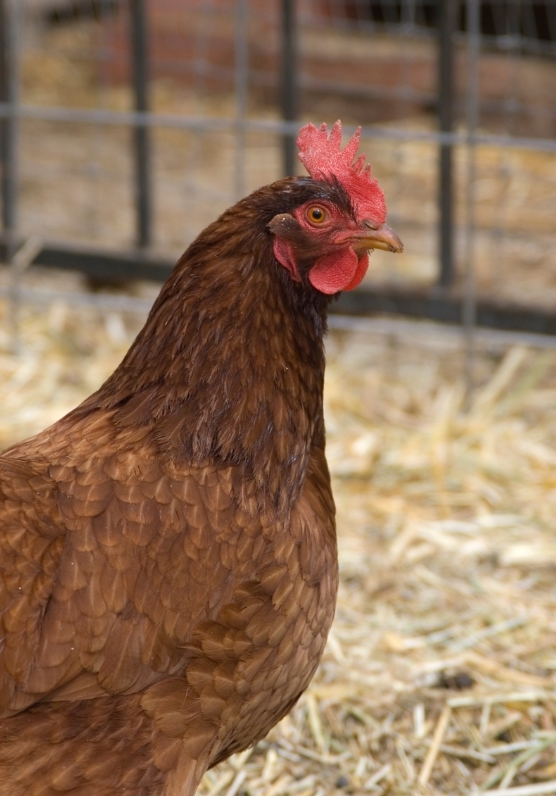
Norwegian Jaerhon
An exceptionally cold hardy egg-laying breed from Norway, Jaerhon chickens are lively and active, rarely settling down.
They have almost no tendency to go broody, and lay an abundance of eggs year-round, only taking a short break during the coldest part of the year.
They ley extra large eggs, which is impressive given their large body size.
- Breed Name: Norwegian Jaerhon (Yarr-hon)
- Breed Type: Layer
- Temperament: Active, energetic, friendly
- Size: Hens 3 lbs, roosters 5 lbs
- Eggs Per Year: 200-250
- Egg Size: Large
- Egg Color: White or tinted
- Feather Type: Standard, clean legs
- Comb Type: Single
- Hardiness: Cold hardy and heat tolerant
- Lifespan: 5+ years
- Time To Maturity: 20-22 weeks

Olive Egger
The Olive Egger is best known for its ability to lay–you guessed it–olive-colored eggs. The Olive Egger isn’t a standardized or recognized breed, but a hybrid. The origins of Olive Eggers are pretty garbled, because an Olive Egger is essentially a combination of any breeds that will produce olive eggs–usually, it’s a mix of a blue-laying breed, like the Ameraucana, and a brown-laying breed, like the Marans. The lineage ultimately depends on the breeder and hatchery. Besides the color, Olive Eggers are great layers because of their consistency. They lay 150-200 eggs per year. Olive is such a nice color to have in your basket! Their eggs can be speckled and come in so many different shades.
As hybrids, you’ll see a lot of different color and feather patterns on an Olive Egger. They might have dark brown or black feathers, muffs, or feathering on their feet–this depends on their parents. In general, Ameraucanas are one of the most common breeds that make up Olive Eggers, so it’s likely that yours will have a pea comb and muffs. Health-wise, Olive Eggers don’t have specific health concerns unique to them. Most Olive Eggers are the offspring of chickens that are very friendly, so it’s likely that yours will be too. They have varying levels of energy and alertness. It’s often a mixed bag, which is what’s so exciting about them!
- Breed Name: Olive egger
- Breed Type: Hybrid layer
- Temperament: Variable; most are docile
- Size: Variable; between 4-8 lbs
- Eggs Per Year: 150-200
- Egg Size: Medium to large
- Egg Color: Olive green
- Feather Type: Hard, clean legs, may have beards and muffs
- Comb Type: Variable, most commonly pea
- Hardiness: Cold hardy and heat tolerant
- Lifespan: 7-10 years
- Time To Maturity: 20-24 weeks

Orpington (Buff, Lavender, etc)
Some of the friendliest chickens anywhere, Orpington chickens are an excellent choice for your backyard flock, especially if you have children. They work well in a community coop with other breeds, provided you don’t keep aggressive breeds that would bully these gentle souls. They’re quiet, which is perfect for the suburbs, and they’re known for their extra fluffy bottoms and broad body shape.
If you’re looking for a friendly, fluffy-bottomed chicken that lays plenty of eggs and still gets large enough to be a good table bird, orpintgons are a great choice. They’re readily available from most hatcheries, and they’re one of the most common breeds.
These dependable, dual-purpose birds will lay 200 to 280 eggs a year in ideal conditions. You can read more about this breed on my detailed Orpington Chicken Breed Guide.
- Breed Name: Orpington
- Breed Type: English, dual-purpose (meat and eggs)
- Temperament: Docile, family-friendly, and relaxed
- Size: Hen 8 lbs, roosters 10 lbs
- Eggs Per Year: 200-280
- Egg Size: Medium to large
- Egg Color: Light brown
- Feather Type: Soft standard, clean legs
- Comb Type: Single
- Hardiness: Cold hardy and heat tolerant
- Lifespan: 8+ years
- Time To Maturity: 20-22 weeks
The benefits of Orpingtons include:
- Good egg layers
- Excellent table meat
- Gentle and affectionate
- Kid-friendly
- Lots of color varieties
- Cold hardy
The downsides of Orpingtons include:
- Costly to feed due to large body size
- 6-12 months to reach full weight
- Difficult to sex
- Can become too heavy to lay well if overfed
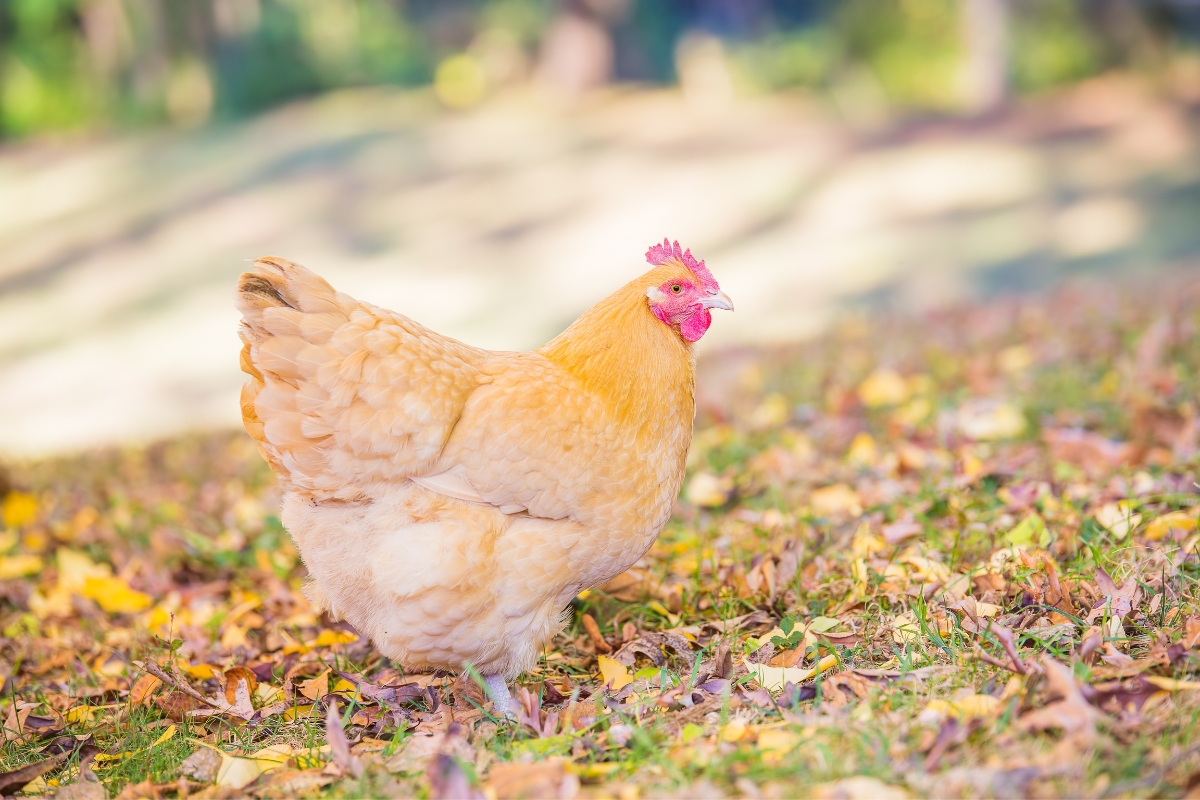
Penedesenca
This Mediterranean chicken breed hails from Spain, and is remarkably heat tolerant. They’re best known for their extra dark brown eggs, and they lay one of the darkest eggs of any chicken breed.
These birds are flighty and noisy, but also good at evading predators and resistant to disease.
They’re an excellent layer for hot regions, especially if you’d like more unique colors in your eggbasket.
- Breed Name: Penedesenca
- Breed Type: Mediterranean, layer
- Temperament: Loud, active, skittish
- Size: Hens 4.5 lbs, roosters 5.5
- Eggs Per Year: 150-200
- Egg Size: Medium to large
- Egg Color: Dark reddish-brown
- Feather Type: Hard, clean legs
- Comb Type: Single
- Hardiness: Heat-tolerant
- Lifespan: 5-8 years
- Time To Maturity: 20-24 weeks
Plymouth Rock (White Rock and Barred Rock)
One of the most common types of backyard chicken, Plymouth Rock chicks can be found at just about every rural feedstore each spring. They’re often sold under the names “barred rock” if they’re speckled black and white, or “white rock” if they’re pure white.
They’re a friendly, dependable dual-purpose chicken breed that everyone seems to love.
- Breed Name: Plymouth Rock (Barred Rock or White Rock)
- Breed Type: Dual-purpose (meat and eggs)
- Temperament: Friendly, docile
- Size: Rooster: 9.5 lbs; hen: 7.5 lbs
- Eggs Per Year: 200-250
- Egg Size: Large
- Egg Color: Shades of brown
- Lifespan: 6-10 years or longer
- Time To Maturity: 8-12 weeks
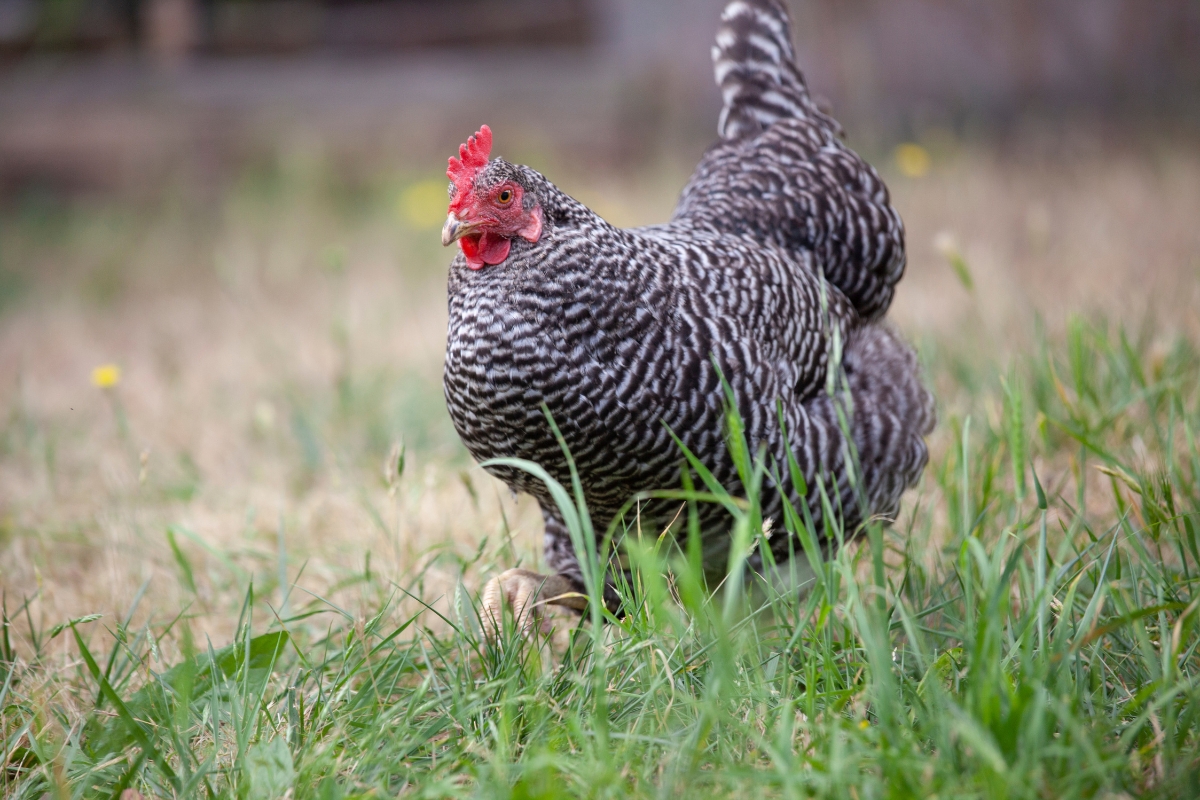
Red Sex Link (Cinnamon Queen, Golden Comet)
The Red Sex Link is a sex-linked breed, meaning you can tell the females from the males as soon as they hatch. The Red Sex Link isn’t a pure breed; it’s a hybrid resulting from the crossbreeding of specific breeds, likely the Rhode Island Red or New Hampshire Red, with light-colored breeds like the White Plymouth Rock or White Leghorn. Interestingly, you can’t get Red Sex-Link chicks from crossing two of them. The exact lineage might vary depending on the hatchery or breeder that they come from, but rest assured, a Red Sex Link will always meet your requirements if you’re looking for a sex-linked layer breed. The ability to sex chicks is especially important for farms that want to produce a lot of eggs.
The Red Sex Link chicken is known to be a good layer, and an efficient one, at that. Red Sex-Link chickens lay a whopping 300 eggs per year! Not only are they superstar layers, they also don’t need to eat a lot to maintain this egg-laying capacity, although they still need proper nutrition.
Red Sex Link hens look very different from roosters, unsurprisingly. A Red Sex-Link hen will be a deep, ruddy red with black flecks, while the roosters tend to have lighter-colored feathers, such as white or yellow. They have single red combs, yellow beaks, and clean yellow legs. Let’s talk about the personality of a Red Sex Link: they love people and are gentle and kind, but towards the rest of their flock, they can be very standoffish. This ultimately depends on their breed makeup, though, and there are plenty of Red Sex Links that can get along well with their flockmates.
- Breed Name: Red Sex Link, Cinnamon Queen, Red Star, Golden Comet
- Breed Type: Hybrid layer
- Temperament: Friendly, active, docile
- Size: Hens 4.5 lbs, roosters 6.5 lbs
- Eggs Per Year: Up to 300
- Egg Size: Large
- Egg Color: Brown
- Feather Type: Hard, clean legs
- Comb Type: Single
- Hardiness: Heat tolerant and cold hardy
- Lifespan: 3-5 years
- Time To Maturity: 20-24 weeks

Rhode Island Red
With up to 300 eggs a year, Rhode Island Red Chickens are one of the very best egg layers anywhere. For that reason, they’re incredibly popular with backyard homesteaders, especially in northern climates.
As a cold hardy bird, they keep laying even when the weather is well below freezing.
They’re considered a dual-purpose bird raised for meat and eggs, and even though they’re great layers, a number of people raise them simply as broilers each year.
With curious, alert and active personalities, they do well free-ranging and forage quite well. In general though, they don’t tolerate confinement.
- Breed Name: Rhode Island Red
- Breed Type: Dual purpose (meat and eggs)
- Temperament: Curious, alert, active
- Size: Hens 6 lbs, roosters 8 lbs
- Eggs Per Year: Up to 300
- Egg Size: Medium to large
- Egg Color: Brown
- Feather Type: Standard, clean legs
- Comb Type: Single Comb
- Hardiness: Cold Hardy and Heat Tolerant
- Lifespan: 5+ years
- Time To Maturity: 16 to 20 Weeks
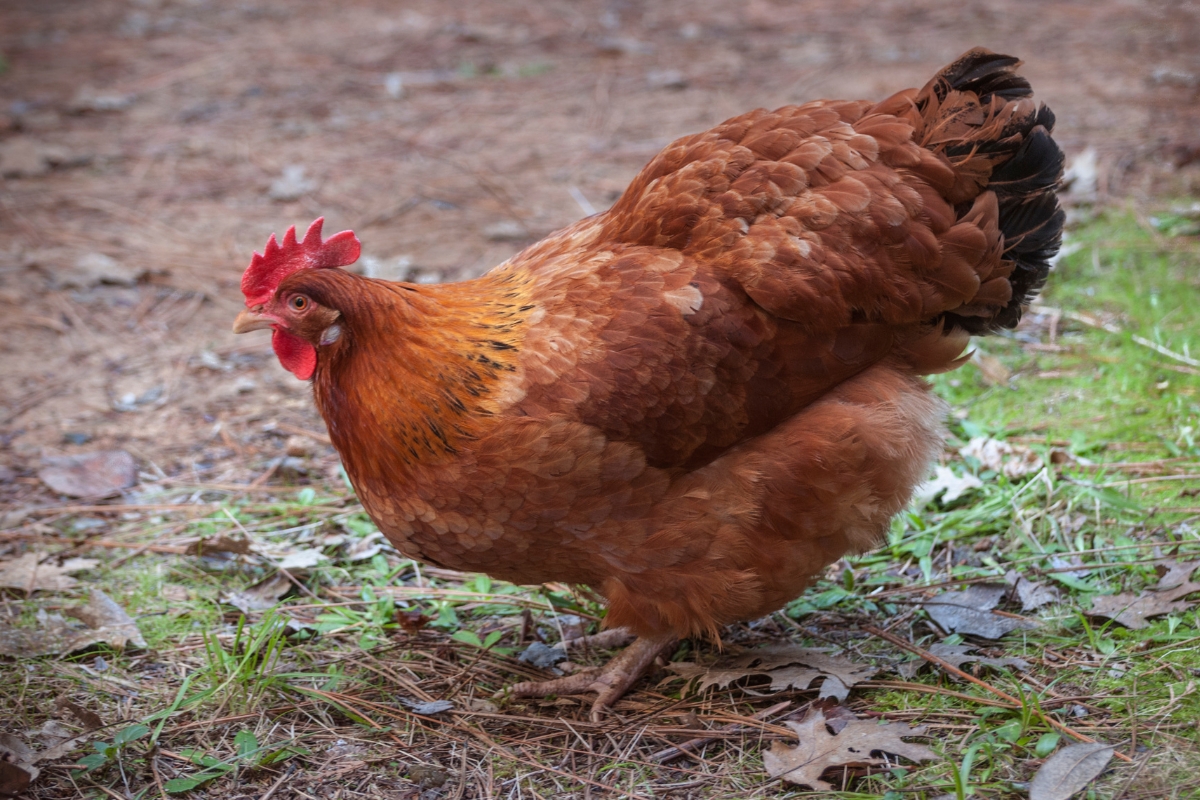
Russian Orloff
A slow-growing hardy Russian Breed, Orloffs are large-bodied egg layers with exceptional cold hardiness.
They used to be a common recognized breed by the APA, but they aren’t any longer simply because they’re relatively rare now.
The main reason is they’re not particularly friendly, and can’t be easily handled. They are independent and self-sufficient and did well on old Russian homesteads with plenty of space to free range…but these days, friendly, fluffy birds in backyard coops are more common.
They don’t lay many eggs, only around 100 per year, but they were raised as a hardy meat breed that more or less raised itself even with slim pickings in cold northern climates.
- Breed Name: Russian Orloff
- Breed Type: Meat
- Temperament: Confident, assertive, independent
- Size: hens 6.5 lbs, roosters 8.5 lbs
- Eggs Per Year: 100-180
- Egg Size: Small to medium
- Egg Color: White, cream
- Feather Type: Standard, with beards, muffs and clean legs
- Comb Type: Cushion (mix of pea and rose)
- Hardiness: Very cold hardy
- Lifespan: 6-8 years
- Time To Maturity: 26-30 weeks
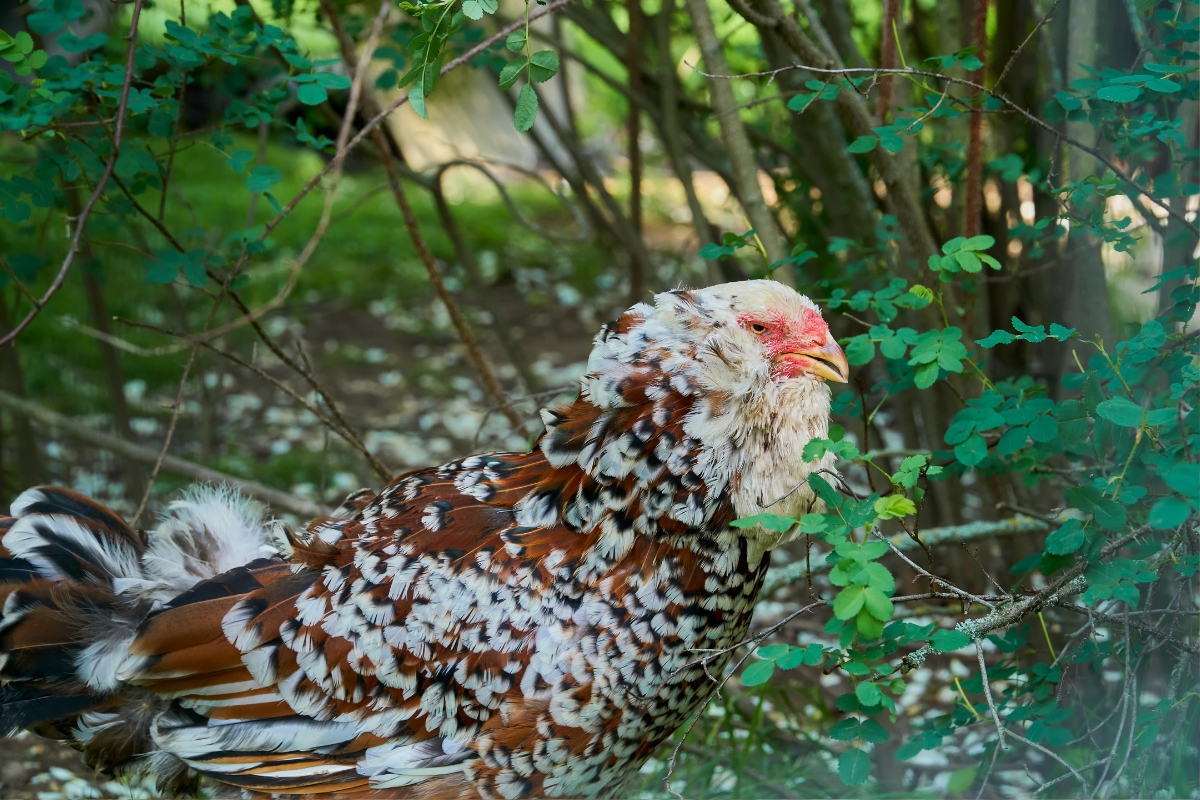
Sussex
Originating in Sussex England, these cold hardy birds are active foragers, no matter the weather. They’re easy to handle, friendly and often go broody.
Sussex chickens are known as a dual-purpose breed and will lay around 200 to 250 eggs in ideal conditions.
They lay around 200 to 250 eggs a year in ideal conditions.
- Breed Name: Sussex
- Breed Type: English, dual-purpose (meat and eggs)
- Temperament: Docile, mellow, affectionate
- Size: Hens 7 lbs, roosters 9 lbs
- Eggs Per Year: 200-250
- Egg Size: Medium to large
- Egg Color: Cream, light brown
- Feather Type: Standard, clean legs
- Comb Type: Single
- Hardiness: Cold hardy and heat tolerant
- Lifespan: 8+ years
- Time To Maturity: 20-22 weeks
Benefits of Sussex Chickens:
- Good Egg Production
- Cold Hardy
- Friendly
Downsides of Sussex Chickens:
- Don’t tolerate confinement
- Not Ideal for Hot Climates
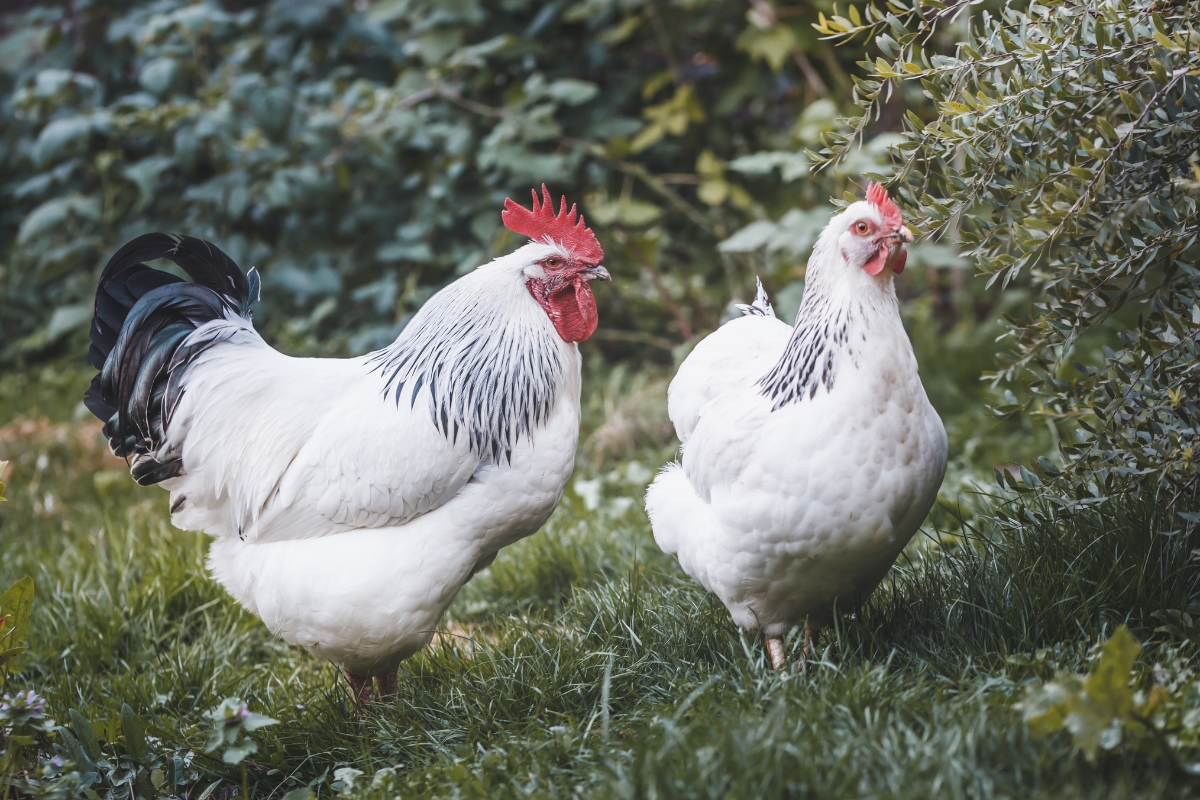
Swedish Black Hen
The Swedish Black Hen is an eye-catching bird. It’s pure black, from its feathers to its bones! The Svart Hona is a rare breed that’s high in demand because of its unbelievable color. It’s deeply tied to Swedish folklore and mythology, with its shadowy appearance.The breed’s exact origins are cloudy, making it even more mysterious. They were likely developed from landrace breeds. Despite its cultural significance, the Swedish Black Hen is among the rarest breeds in the world–there are only about 500 in Sweden, and fewer in the rest of the world.
The Swedish Black chicken is fibromelanistic, meaning it’s black through and through. They have glossy, iridescent feathers with a green sheen that make them look like ravens. Swedish Black Hens have single combs that are black. Even their organs are black. Because of their rarity, Swedish Black Hens are almost always kept as ornamental birds, but they lay lots of eggs, too–up to 250 per year! Their eggs aren’t black, but a creamy white.
The Swedish Black Hen is sleek with a medium-sized build. Health-wise, Swedish Black chickens are hardy, excelling in free ranging. They also do well in the cold, but make sure to tend to their single combs to prevent frostbite. Swedish Black Hens are very smart birds, acting with alertness and caution. They’re active and expert foragers that don’t need too much monitoring. Feel free to marvel at your Svart Honas from afar, because they’re not the cuddliest of chickens!
- Breed Name: Swedish Black Hen, Swedish Black chicken, Svart Hona, Svarthöna
- Breed Type: Ornamental
- Temperament: Cautious, flighty, active
- Size: Hens 4 lbs, roosters 7 lbs
- Eggs Per Year: 200-250
- Egg Size: Medium
- Egg Color: Cream
- Feather Type: Hard, clean legs
- Comb Type: Single
- Hardiness: Cold hardy
- Lifespan: 5-8 years
- Time To Maturity: 24-26 weeks
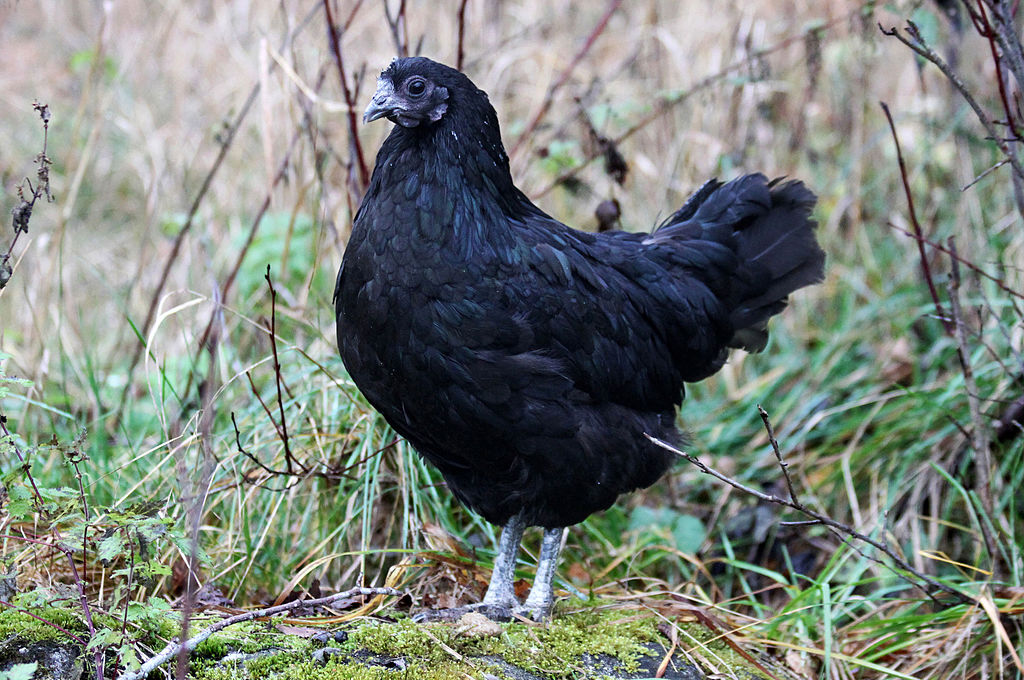
Swedish Flower Hen
The Swedish Flower Hen is also known as the Skånsk blommehöna, which literally means Skansk bloom hen. The Swedish Flower Hen originates from the Skanks region of Sweden, and its mottled plumage makes it look like it’s covered in flowers. This landrace breed has a lot of significance in southern Sweden; its origins can be traced back to Viking times! Nowadays, the Swedish Flower Hen is an endangered breed, nearly going extinct in 1970. Thankfully, some passionate breeders dedicated their careers to reviving this beautiful heritage breed, and they’re bouncing back very slowly.
The Swedish Flower Hen is a dual-purpose breed, meaning it’s used both as an egg-layer and a source of meat. Swedish Flower Hens lay 150-200 cream-colored eggs per year. Even if they don’t produce nearly as many eggs as a hybrid breed, people claim that Swedish Flower Hens make exceptionally delicious eggs. Because of their Swedish heritage, they’re fine with laying through colder months, as well. With a weight of up to 8 lbs, Swedish Flowers provide a good carcass with flavorful meat.
While they’re known as dual-purpose birds, it’s not unlikely that Swedish Flower Hens are kept as ornamental pets. There are so many colors that this breed comes in. Swedish Flower Hens can be blue, red, black, orange, or brown, and their feathers will most likely have white spots. They have a medium-sized build with a robust and well-rounded body, along with a bright red comb and wattles. Health-wise, Swedish Flower Hens are very hardy, given their landrace heritage. They’re surprisingly tolerant towards damp environments; they’re accustomed to the cold, but they’re fine with the heat as well. Swedish Flower Hens make wonderful companions, too. They’re very friendly and docile. It’s easy to handle a Swedish Flower Hen, and they’re very proud, regal birds.
- Breed Name: Swedish Flower Hen, Skånsk Blommehöna
- Breed Type: Dual-purpose
- Temperament: Calm, docile, independent
- Size: Hens 5.5 lbs, roosters 8 lbs
- Eggs Per Year: 150-200
- Egg Size: Large
- Egg Color: Cream
- Feather Type: Hard, clean legs, may have crests
- Comb Type: Single
- Hardiness: Cold hardy
- Lifespan: Up to 10 years
- Time To Maturity: 20-24 weeks
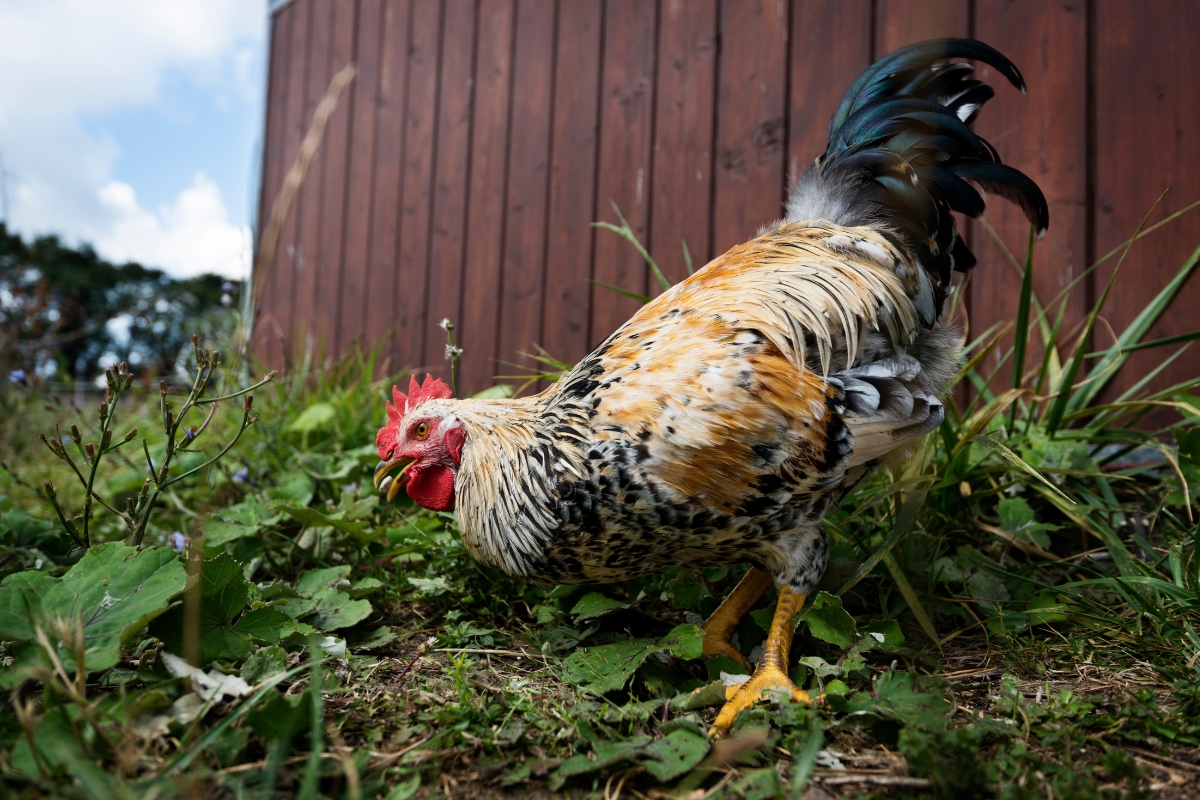
Turken (Naked Neck)
One of the strangest looking chicken breeds, the Turken or “Naked Neck” chicken, is sure to turn some heads. They have completely bald necks, which helps them survive extreme heat, but they’re obviously less cold-tolerant than other breeds.
They’re a dual-purpose breed, kept for both eggs and meat, producing a respectable 150 to 180 eggs a year and dressing out to a good-sized roasting bird (with less plucking).
Chicken keepers love them as pets, as they’re friendly, docile, and affectionate. They have fewer feathers on most of the rest of their bodies, too, which means they don’t fly at all and are easy to keep contained.
- Breed Name: Transylvanian naked neck, showgirl, turken
- Breed Type: ornamental, dual-purpose (meat and eggs)
- Temperament: Friendly, docile and affectionate
- Size: 7 lbs
- Eggs Per Year: 150-180
- Egg Size: Medium
- Egg Color: Light brown
- Feather Type: Hard, clean legs, no feathers on legs, head, neck, or rump
- Comb Type: Single
- Hardiness: Heat-tolerant
- Lifespan: 8+ years
- Time To Maturity: 20-22 weeks

Vorwerk
The Vorwerk chicken is a pretty new breed that was developed in Germany in the early 20th century. The German breeder Oskar Vorwerk wanted to create an efficient dual-purpose breed with a very specific color pattern. He wanted it to resemble the Lakenvelder. It’s easy to identify a Vorwerk and tell it apart from the Lakenvelder, which has a white body.
The Vorwerk has a very unique color pattern–their body is gold, sometimes with black or brown and black barring, and a black head. Their skin is slate gray. Their single combs are red, and their earlobes are white. Their eyes are orange. Talk about a rainbow!
The Vorwerk was designed to be a dual-purpose breed. They are good layers of medium-sized brown eggs, averaging around 150 to 200 eggs per year. Vorwerks also mature very quickly, and a full-sized Vorwerk is between 5-7 lbs, making them decent for butchering. Vorwerks are very hardy birds. They’re active and alert, making them great for hands-off owners. You don’t have to worry too much about predators, as the Vorwerk can be pretty flighty. They love foraging and thrive in free-range, but they’re fine in confinement as well.
- Breed Name: Vorwerk
- Breed Type: Dual-purpose
- Temperament: Active, alert, flighty
- Size: Hens 5 lbs, roosters 7 lbs
- Eggs Per Year: 150-170
- Egg Size: Medium
- Egg Color: Cream
- Feather Type: Hard, clean legs
- Comb Type: Single
- Hardiness: Cold hardy
- Lifespan: 5-10 years
- Time To Maturity: 20-24 weeks
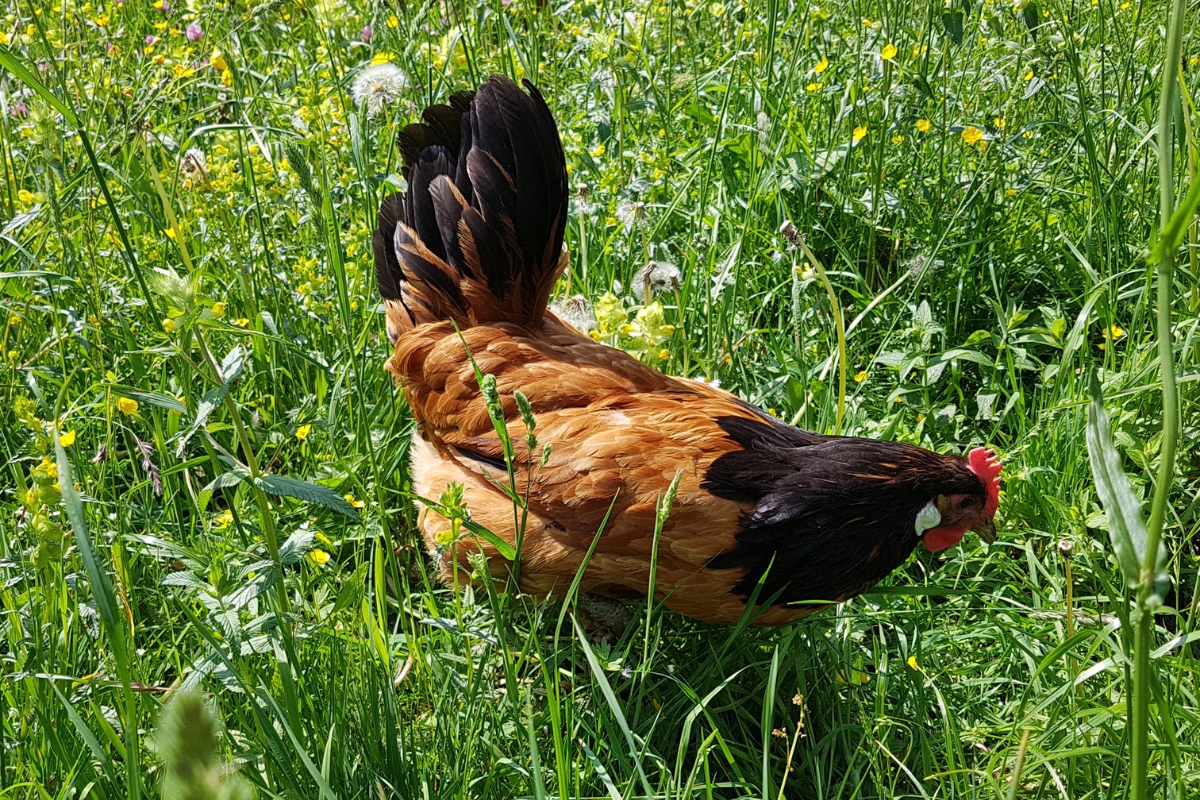
Welsummer
A heirloom breed from the Netherlands, Welsummer chickens have many things going in their favor. They’re dual-purpose birds with excellent cold hardiness, and they lay around 150 to 200 eggs per year.
Their exceptionally attractive plumage adds interest to backyard flocks, and they lay a striking dark brown egg that will be the star of your eggbasket.
Known as one of the friendliest chicken breeds, Welsummers commonly show a lot of attachment to and affection for their owners.
- Breed Name: Welsummer
- Breed Type: Continental, dual-purpose (meat and eggs)
- Temperament: Friendly, docile, calm
- Size: Hens 6 lbs, roosters 8 lbs
- Eggs Per Year: 150-200
- Egg Size: Large
- Egg Color: Dark brown
- Feather Type: Standard, clean legs
- Comb Type: Single
- Hardiness: Cold hardy and heat tolerant
- Lifespan: 6-10 years
- Time To Maturity: 20-24 weeks
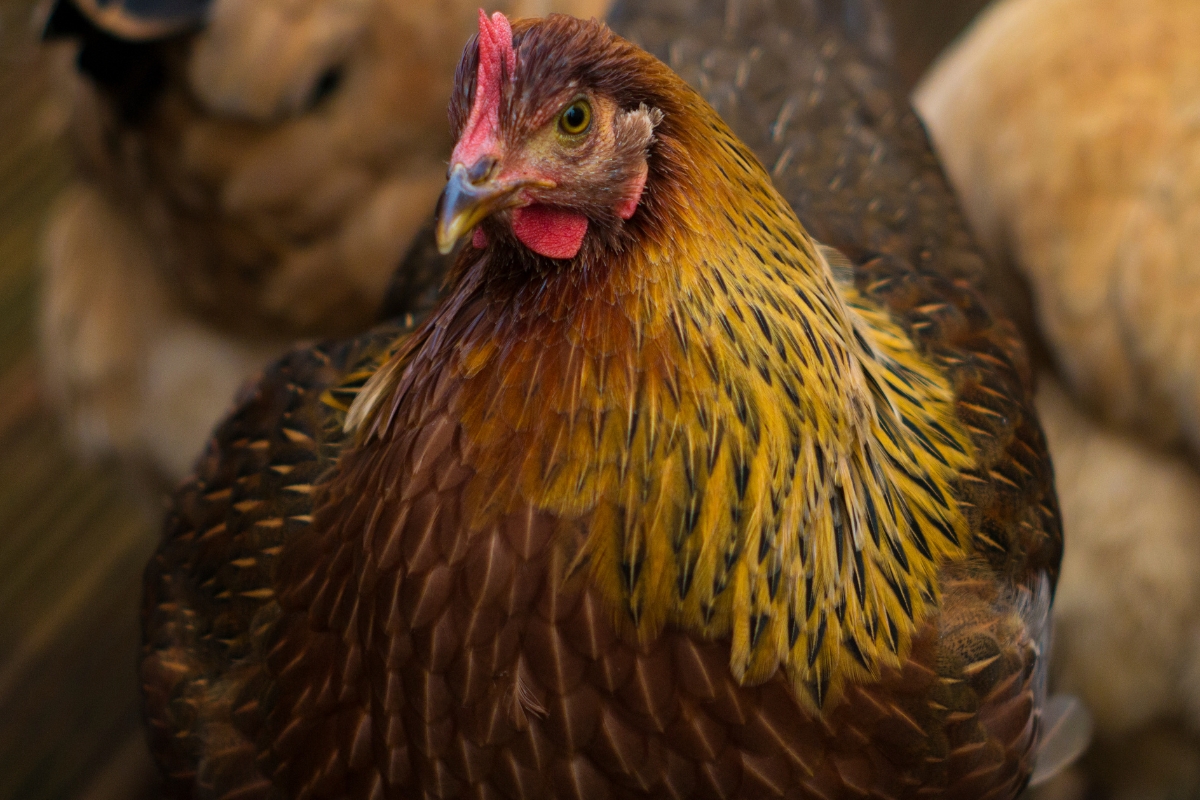
Whiting True Blue
Originally developed as a blue egg laying breed that “breeds true,” the Whiting True Blue mixed strong egg laying lines with blue egg genes to create a new chicken breed with excellent laying potential. These chickens are some of the best layers out there, laying 250 to 300 eggs per year. All of them blue!
The birds themselves come in a rainbow of stunning colors including wheaten, blue, red, and more.
They’re independent, predator-aware, and highly active foragers, making them a great choice for free-ranging flocks.
- Breed Name: Whiting True Blue
- Breed Type: Layer
- Temperament: Independent, active
- Size: Medium, 5-7 lbs
- Eggs Per Year: 250-300
- Egg Size: Medium to large
- Egg Color: Blue
- Feather Type: Standard, clean legs
- Comb Type: Pea Comb
- Hardiness: Cold hardy & heat tolerant
- Lifespan: Five years or more
- Time To Maturity: 20 weeks
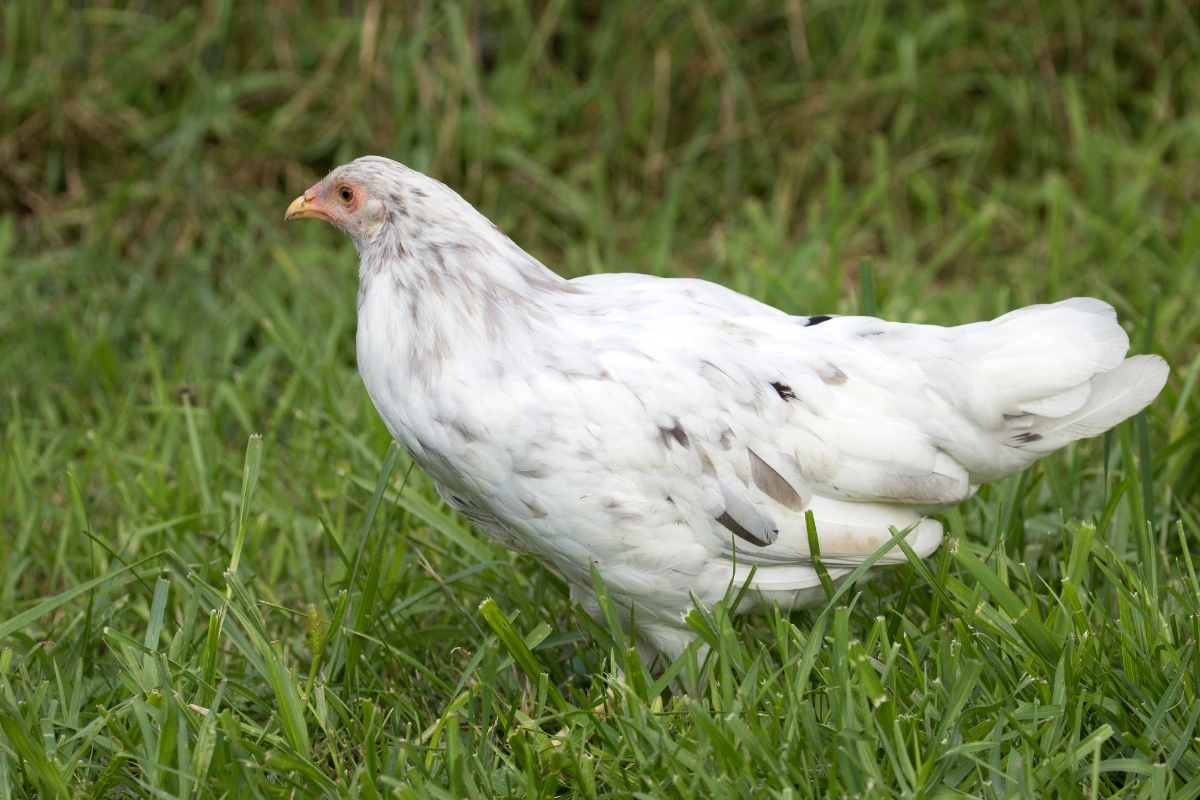
Wyandotte
Bred as a dual-purpose chicken that could survive harsh winters in upstate New York, Wyandottes are a heavy breed with dense feathers and excellent egg-laying abilities.
Their dense feathers help protect them from the cold, but the breeders also took care to choose stock that had striking color patterns as well, and the silver-laced and golden-laced wyandottes are some of the most popular.
They’re generally independent and not particularly attached to people, so don’t expect chicken cuddles. That said, they’re not aggressive toward people either, just indifferent, and they do well in mixed flocks. These are pretty looking at chickens, not lap chickens.
- Breed Name: Wyandotte
- Breed Type: American, dual-purpose (meat and eggs)
- Temperament: Aloof, calm, independent
- Size: Hens 6 lbs, roosters 9 lbs
- Eggs Per Year: 200-260
- Egg Size: Medium to large
- Egg Color: Brown
- Feather Type: Standard, clean legs
- Comb Type: Rose
- Hardiness: Cold hardy and heat tolerant
- Lifespan: 6+ years
- Time To Maturity: 20-22 weeks

Chicken Keeping Guides
Looking for more chicken-keeping guides?
- How Much Does it Cost to Keep Chickens?
- Beginner’s Guide to Chicken Egg Colors
- What’s the Difference Between a Duck Egg and a Chicken Egg?
- How to Raise Chickens (Beginner’s Guide)
- How to Raise Baby Chicks into Adult Hens
- 12 Best Egg Laying Chickens for Beginners
